Free Compare and Contrast Essay Generator
State the point to be discussed in your body paragraph
State a supporting point to be discussed in body paragraph
State an opposing point to be discussed in body paragraph
State a similar aspect to be discussed
State a contrasting aspect to be discussed
Are you familiar with this feeling? Being stressed out, staring at a blank screen, and not knowing how to start your essay. But what if we say that there is a super-handy app that can eradicate this problem for you 100% free?
Meet our compare and contrast essay generator! It’s a revolutionary tool that will boost your inspiration and help you improve the quality of your papers.
- ️🔥 How to Use Our Tool
- ️🎉 Why Use Our Essay Generator
- ️💡 What Is a Compare and Contrast Essay?
- ️📝 Compare and Contrast
- ️✍️ How to Write
- ️🔗 References

🔥 How to Use Our Compare and Contrast Essay Maker
Our app is so easy to use that it takes seconds to master:
- Type in your topic.
- Specify the number of similar aspects.
- Select the number of contrasting parameters.
- Customize the main body by adjusting the app’s settings.
- Press “Generate” and get an astonishing result.
🎉 Why Use Our Compare and Contrast Essay Generator
It won’t be an overstatement to say that our app is one of the best you can find online. Here are its benefits:
💡 What Is a Compare and Contrast Essay?
Compare and contrast essays require students to parallel two or more subjects together. The goal is to examine their similarities and differences and draw a conclusion from this analysis. The comparison subjects are often taken from the same category. For example, you can compare fruits, universities, cars, movies, etc.
📝 Compare and Contrast Essay Structure
You might be wondering how to organize your compare and contrast essay. Well, there are two outline techniques that you can choose from. You can make a compare-and-contrast essay outline using the block approach or point-by-point method.
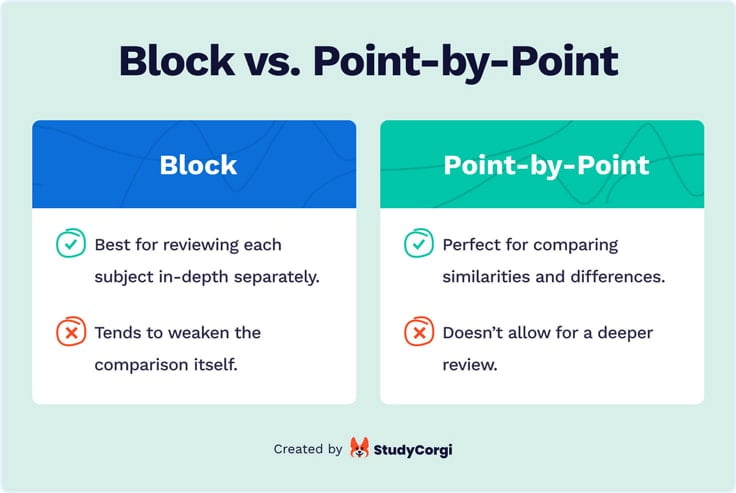
Point-by-Point Method
The point-by-point format lists each similarity and difference altogether. For example, you can start by mentioning a unique quality of one subject and then discuss how it relates to or differs from the other subject. The template of the point-by-point method is as follows:
Block Method
The block format presents the subjects separately. This means that the first body paragraph will include only the properties and characteristics of one thing. The second subject is covered the same way only after you've thoroughly reviewed the first one. The template of the block method is as follows:
✍️ How to Write a Comparison Essay
At first, it may seem that compare and contrast essays are very complicated, but if you know all the details, the writing process becomes very easy. The step-by-step guide below will describe the entire process of essay writing. Use it to boost your knowledge!
1. Brainstorm
The best compare and contrast essays require finding all of the possible traits and parallels of two things. So, before you start writing, you'll need to brainstorm ideas and see all these properties of the chosen subjects.
One of the best ways to do it is to use a Venn diagram . It helps to visualize all the similarities and differences between two or more things. In a Venn diagram , overlapping circles are used to represent the properties of the subjects. One circle represents the first subject, another represents the second one, and so on. The similarities are placed in the middle where the circles overlap, while distinct properties are placed further within the circles.
Here’s an example of a Venn diagram:
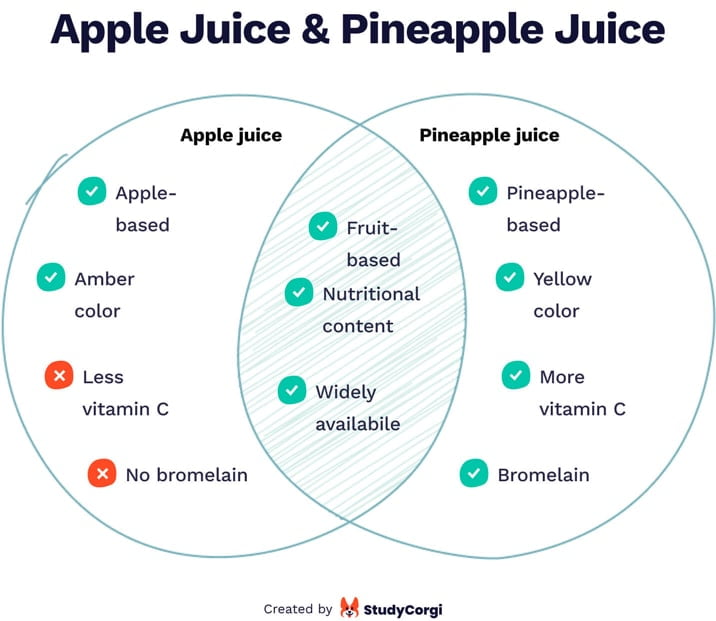
2. Make an Outline
After you’ve determined all the traits of your subjects, you can move on to outline your essay . It will come in handy to avoid repeating yourself and forgetting to add key arguments.
A compare and contrast essay outline uses the traditional essay structure of an introduction, body paragraphs, and conclusion. All you have to do is to choose between the point-by-point and block methods.
3. Write a Draft
You’re now ready to begin the writing phase. At this point, all you have to do is glue everything from your outline together. Simply collect all your arguments and write them down alongside examples. Make sure to include all the key points. Also, do your best to follow the logic and avoid making groundless claims.
You can also use our compare-and-contrast essay generator to make a couple of flawless drafts that can be used as examples or as the foundation for your own essay.
After the draft is complete, we advise you to spend as much time as necessary polishing the quality of your arguments and overall structure. Make sure that your essay follows either the block or point-by-point method. Also, it’s vital to ensure that each subject has enough attention in your essay's body paragraphs.
5. Proofread
The last thing left is to correct all the possible mistakes. Follow this checklist to complete it:
- Locate and fix all grammatical and punctuation errors.
- Try to imagine yourself as the reader. It will help you become more attentive to details. Additionally, ask for a review of your essay from friends or family members.
- Use assistance apps like Grammarly .
Now you know what it takes to write an excellent comparison essay! Feel free to use our compare-and-contrast essay maker to boost your creativity and writing skills.
We also recommend using our hook sentence generator and essay outline maker .
❓ Compare and Contrast Essay Generator FAQ
❓ how do you write a compare and contrast essay.
The writing process begins with researching two or more subjects and finding their traits and parameters. Afterward, you create an outline based on either point-by-point or block structure. Once the outline is complete, you can write the first draft. Then all that’s left is to correct the draft and make sure it’s flawless.
❓ What Is the Purpose of a Thesis in a Compare and Contrast Essay?
The purpose of a compare and contrast essay thesis is to highlight the similarities and differences between 2 or more individuals, concepts, objects, etc. The thesis also evaluates the importance of reviewing and comparing these things.
❓ How Many Paragraphs Are in a Compare and Contrast Essay?
A standard compare and contrast essay consists of 3 or more paragraphs. That includes the introduction with a thesis, the main body with arguments, and a conclusion. The number of arguments can differ depending on how many traits and properties the subjects under comparison have.
❓ What Is the Structure of a Comparison Essay?
There are two methods of organizing a comparison essay’s structure. The first one is called a point-by-point method that compares all the similarities and differences together. The second technique is known as the block method. It uses blocks that include a detailed review of one subject at a time.
🔗 References
- The Compare/Contrast Essay: What It Is and How to Construct One: Bellevue College
- How to Write a Compare and Contrast Essay: MasterClass
- Organizational Patterns for the Comparison/Contrast Essay: San Jose State University
- Comparing and Contrasting: The University of North Carolina at Chapel Hill
- Writing a Paper: Comparing & Contrasting: Walden University
Feb 15, 2023
How to write a Compare and Contrast Essay | Outlines and Examples
Need help writing a compare and contrast essay check out these tips and examples to get you started.
A compare and contrast essay is a differentiation of two or more topics, explaining similarities and differences between them through an essay writing format. It is essential that each topic is clearly highlighted in order to be accurately compared.
This form of academic writing works best for essay topics that have similarities to be compared to each other. For example, you can compare and contrast two novels or authors, or two school subjects or cuisines. In order to write this type of essay well, it is important to conduct research and use reliable sources to ensure the accuracy of your work.
If you want to write high-quality compare-and-contrast essays, we recommend using Jenni.ai's Free Essay Writer for AI assistance. Get your essays done 10x faster with the help of artificial intelligence!
What is a compare and contrast essay?
A compare and contrast essay is a type of written work where the writer analyzes and compares two or more subjects to identify their similarities and differences (e.g., cats and dogs as pets). This essay is a useful tool for gaining a deeper understanding of the subjects being compared and for improving our knowledge of them.
In a compare and contrast essay, the first step is to identify the subjects that will be analyzed. This could also be two books, historical events, pieces of art, or any other subjects that can be compared. The writer must then gather information on each of the subjects in order to develop a strong thesis statement.
The body of the essay is where the writer compares and contrasts the subjects. This can be done in a point-by-point or block comparison format. The conclusion should summarize the main points of the essay and restate the thesis statement in a new, more insightful way.
Types of Compare and Contrast Essays
A compare-and-contrast type of essay has two main approaches. There is the block method and the point-by-point style. Let's dive a little deeper into each one!
Block Method - The block method presents all arguments related to the initial statement in the essay and compares them directly to the opposing statement. The purpose is to provide an in-depth analysis of each point by presenting supporting evidence in the form of examples that focuses on one statement over the other.
Phrases such as "in relation to" or "in the same way" is best used in the block method as it helps establish the relationship between each argument. Keep in mind that in order for the points to be presented effectively, these quotes are presented in relation directly to the initial statement in order to analyze the relationship between the two subjects.
Point-by-point Method - The point-by-point method presents an argument for each point that is directly compared against the opposing statement. In this method, the writer focuses on one point or aspect at a time, describing both statements and how they are similar or different in a precise manner.
This method is used more in academic writing and essay writing because it is simpler and easier to use than the block method. However, writers are not discouraged from using either approach as long as they understand how to effectively use each of them.
Tips on how to create your Compare and Contrast Essay
Creating a compare and contrast essay is relatively simple once you understand the basic concepts behind it. Here are some helpful tips to get you started with creating a high-quality essay:
Create a general overview that defines each of the paragraphs and how they relate to each other. This is essential after doing research to give the readers a general idea of what the essay will be about.
Create a structure for your paper by creating a roadmap for each paragraph that clearly outlines how the information will be presented. This will help the writer structure their thoughts and ideas and make sure nothing is left out or forgotten about during the editing process.
Transitions are very useful in comparing and contrasting essays as they provide a clear connection between each point being discussed and how it relates to the other points.
Create symmetrical comparisons when presenting your ideas to the readers to ensure everything is explained properly. For example, if you are comparing and contrasting two literary works, it should be clear for the reader how the ideas presented in one work relate to the ideas presented in the other work.
After finishing your entire essay, make sure to proofread and edit accordingly to make sure that all the relevant talking points are panned out correctly throughout the whole essay structure.
How to Outline Compare and Contrast Essays?
Now that we have talked about the basics of a compare and contrast essay, we will now talk about the process and steps for outlining to help you out accomplish your essay effectively.
Block Method Outline:
In a block format compare and contrast essay, the writer discusses all the similarities and differences between one subject before moving on to the next subject.
Here is an example of how the block format in a compare and contrast essay might be structured:
I. Introduction Paragraph
A. Background information on the subjects being compared and contrasted
B. Thesis statement outlining the purpose of the essay
II. Block format of Subject 1
A. Detailed description of Subject 1
B. Analysis of the similarities and differences between Subject 1 and Subject 2
III. Block format of Subject 2
A. Detailed description of Subject 2
B. Analysis of the similarities and differences between Subject 2 and Subject 1
IV. Conclusion
A. Summary of the main points of the essay
B. Restatement of the thesis statement in a new, more insightful way
In this format, the writer first provides a detailed description of one subject and then analyzes its similarities and differences with the other subject. This is repeated for the second subject, ensuring that all similarities and differences are thoroughly discussed. This format allows the writer to provide a comprehensive analysis of each subject before moving on to the next, making it a useful format for writing a detailed and thorough compare-and-contrast essay.
Point by point Method:
A point-by-point compare and contrast essay is a type of essay where the writer compares and contrasts two or more subjects by discussing a specific aspect or point of each subject in relation to the other.
Here is an example of how a point-by-point compare and contrast essay might be structured:
I. Introductory Paragraph
II. Point 1: Comparison of aspect 1 of Subject 1 and Subject 2
A. Analysis of aspect 1 of Subject 1
B. Analysis of aspect 1 of Subject 2
C. Comparison and contrast of aspect 1 of Subject 1 and Subject 2
III. Point 2: Comparison of aspect 2 of Subject 1 and Subject 2
A. Analysis of aspect 2 of Subject 1
B. Analysis of aspect 2 of Subject 2
C. Comparison and contrast of aspect 2 of Subject 1 and Subject 2
IV. Point 3: Comparison of aspect 3 of Subject 1 and Subject 2
A. Analysis of aspect 3 of Subject 1
B. Analysis of aspect 3 of Subject 2
C. Comparison and contrast of aspect 3 of Subject 1 and Subject 2
V. Conclusion
In this format, the writer focuses on one aspect or point at a time, comparing and contrasting it between the two subjects. This allows the writer to provide a detailed and thorough analysis of each aspect, making it a useful format for writing a highly specific and focused compare-and-contrast essay.
Compare and Contrast Essay Examples
Now that we have talked about all the essential things needed to create a compare and contrast essay, let's move on to some examples that will inspire you to create your very own essay!
Example #1: iPhone vs. Android: Which is better for you?
"The iPhone vs. Android comparison is a never-ending debate on which one is best. It will likely never have a real winner, but we're going to try and help you to find your personal pick all the same.
The latest version of both operating systems — iOS 16 and Android 13 — are both excellent, but in slightly different ways. Many of their features overlap, but design-wise they look quite different, aside from the basic touchscreen-focused layout. Whichever of the best phones available today you buy, they'll be running one of these two OSes.
Pitting iPhone vs. Android, we take a look at the respective strengths of each mobile platform, so you can pick the right one for you the next time you buy a smartphone. If you want to see the current flagships for Android and iOS, be sure to check out our Pixel 7 Pro vs. iPhone 14 Pro Max and Pixel 7 vs. iPhone 14 face-offs. And if you're convinced to want to leave your iPhone, read more about Google's new Switch To Android app that will help you move over.
Why iPhone is better
You're invested in Apple's ecosystem. This might seem like a shallow reason, but Apple obviously makes a wide breadth of tech products, and if you already own a Mac, iPad or Apple Watch, getting an iPhone makes a lot of sense.
Apple has designed a multitude of continuity features that allow you to carry over work and data from one of its devices to another, and these features can certainly save you time. Take Handoff, for example, where calls on your iPhone and web pages in Safari can move seamlessly between iOS and macOS. Universal Clipboard makes text copied on one platform usable on the other. Another one of our favourites is Continuity Camera, which allows you to take pictures and scan documents using your iPhone's camera, and then view and edit them on your Mac. You can even complete purchases on your Mac by using biometric authentication features on your iPhone via Apple Pay.
Only a handful of Android phone makers have hardware ecosystems that approach Apple's, and even for some that come close, like Samsung, you won't get the depth of integration possible between the iPhone and other Apple-built devices. Microsoft is helping Google close the gap somewhat with its new Your Phone app for Windows, which allows Android users to respond to texts and notifications on their PCs, though the experience is a little clunky and there is still work to be done."
Example #2: MOBILE HOME VS TINY HOUSE | SIMILARITIES, DIFFERENCES, PROS & CONS
"A BRIEF OVERVIEW OF THE TINY HOUSE MOVEMENT
Interestingly, the modern tiny house movement sprouted in the 1980s, increasing in popularity these last three decades. Thanks to blogging, books, and magazine spotlights, the tiny house bug has spread and grown significantly.
While the real estate crisis has had an impact on the tiny house movement’s popularity, that’s not all that makes it appealing.
People love the tiny house options for practical, ethical, and emotional reasons.
PRACTICAL REASONS
Additionally, choosing a smaller home can save you lots of money. You’ll spend less on utilities. Maintenance will cost you less as there is not so much house to maintain and remodel. They are more economical than a stick-built home, and your property taxes are something to brag about.
Another practical point is minimalism in your belongings. In a tiny home, you will have no choice but to whittle down your belongings to what you will actually use. There is freedom in this.
ETHICAL REASONS
From an ethical standpoint, tiny house proponents are environmentally friendly. They use less CO2 than the average home. Due to the smaller space, energy spent on heating and cooling is greatly reduced. Oftentimes these tiny homes are made out of recycled materials. They are usually self-sufficient, making use of renewable energies such as rainwater. Thus they provide homeowners with everything they need.
Homeowners like to choose the way of the tiny home in an effort to help the environment.
There you have it. A brief scoop on the mobile home vs tiny house movement. We hope you found this article interesting and helpful."
Creating compare-and-contrast essays is quite fun to write especially if you have familiarized yourself with the topics at hand. Just make sure to keep our tips in mind to create high-quality essays.
If you want your compare-and-contrast essays done 10x faster, we recommend using Jenni.ai along with the tips and guidelines we provided you in this post. Jenni.ai is a fantastic AI software that aids your essay writing process so that you could produce your writing needs faster and better than ever!
Try Jenni for free today
Create your first piece of content with Jenni today and never look back
Compare and Contrast Essays: Explained with Examples
- December 20, 2023
Compare and contrast essays are one of the most common academic writing assignments. As the name suggests, these essays focus on analyzing the similarities and differences between two or more subjects or ideas. This type of essay is often assigned in various courses ranging from literature to social sciences.
A compare and contrast essay aims to develop critical thinking and analytical skills. By comparing and contrasting different subjects, students can look at them from a new perspective and better understand their similarities and differences. This article will discuss the key elements of writing a successful compare-and-contrast essay.
What are Compare and Contrast Essays?
A compare and contrast essay is a specific type of essay that focuses on examining and evaluating the similarities and differences between two or more related subjects. These subjects can be anything from people, events, books, theories, objects, or places. This type of essay aims to develop a deeper understanding of the chosen subjects and present it to the reader in an organized and coherent manner.
Key Elements of Compare and Contrast Essays
Identification of Similarities and Differences: The first step in writing a compare and contrast essay is identifying the key similarities and differences between the subjects. This will help in setting the foundation for your comparison.
Developing a Thesis Statement: A thesis statement is the main argument of your essay. It should be clear, concise, and specific, highlighting the main points of comparison or contrast between the subjects.
Organizing the Essay: There are two common ways to organize a compare and contrast essay:
Subject by Subject: The first section will discuss one subject’s similarities and differences, followed by the second subject in the next section.
Point by Point: Each paragraph will focus on a specific point of comparison or contrast between the subjects.
Supporting Evidence: To make your arguments more convincing, it is important to support them with evidence. This can include examples, statistics, or quotes from reliable sources.
Conclusion: The conclusion of a compare and contrast essay should summarize the main points and restate the thesis statement in light of the arguments presented.
How to Write a Compare and Contrast Essay
Writing a compare and contrast essay involves examining the similarities and differences between two or more subjects, providing insights into their relationships, and drawing meaningful conclusions.
Choose Your Subjects : Start by selecting two subjects that share similarities but differ clearly. These could be characters from two different novels, two theories in psychology, or two historical events.
Identify the Points of Comparison or Contrast : Note the similarities and differences between your chosen subjects. This will form the basis of your comparison or contrast. You can use a table to display these points. In one column, list the features of one subject, and in the second column, list the features of the other. This will make it easier to see the points of comparison or contrast.
Incorporate Tables for Organization : Tables systematically organize your points of comparison and contrast and simplify drafting your essay. By arranging your points in a table, you can effortlessly compare and contrast the features of your subjects side by side. This helps you maintain a clear focus, prevents any key points from being overlooked, and serves as a quick reference guide during the writing process.
Use a Venn Diagram : A Venn diagram visualizes the overlap and differences between your subjects. Draw two overlapping circles, one for each subject. The overlapping area will represent the similarities, while the non-overlapping areas will represent the differences .
Develop Your Thesis and Essay Structure : Based on your Venn diagram and table, decide on your main points of comparison or contrast and develop your thesis statement. Plan the structure of your essay, deciding whether to use a subject-by-subject or a point-by-point structure.
Write and Edit Your Essay : Start writing your essay by introducing your subjects and thesis statement. Then, proceed with the body paragraphs, each covering a point of comparison or contrast. Use evidence from your table and Venn diagram to support your points. Finally, write a conclusion that links your points and restates your thesis. Be sure to review and edit your essay for clarity and coherence.
Topic Examples for Compare and Contrast Essays
Selecting compelling subjects for a compare and contrast essay can be thought-provoking, as it entails identifying diverse topics that share commonalities and differences, sparking insightful comparisons.
Comparison between two types of music genres (e.g., rock vs. pop).
Differences in the two countries’ education systems (e.g., US vs. UK).
Similarities and differences between two historical figures (e.g., Martin Luther King Jr. vs. Nelson Mandela).
Comparison of two art movements (e.g., Impressionism vs. Cubism).
Contrast between two leadership styles (e.g., autocratic vs. democratic).
Differences in the lifestyles of people living in urban and rural areas.
Comparison of two methods for solving a common problem (e.g., traditional vs. modern medicine).
Similarities and differences between two famous novels or movies.
Contrast between two different sports (e.g., basketball vs. soccer).
Comparison of two political systems (e.g., democracy vs. dictatorship).
Compare & Contrast Essay: Introduction Paragraph
When writing a compare and contrast essay, it is important to have a strong introduction that captures the reader’s attention and sets the tone for the rest of your essay. Here are some tips and examples for writing an effective introduction paragraph:
Start with an Interesting Hook
Begin your essay with an attention-grabbing statement or question related to your topic. This will pique the reader’s interest and make them want to continue reading.
Example: Did you know that rock and pop music have more in common than you might think?
Provide Background Information
Give some context about your topic to help the reader understand the purpose of your essay. This could include a brief history or explanation of the topics you will compare and contrast.
Example: Rock and pop music have been two of the most popular genres since the 1950s, but they have distinct differences that make them unique.
State Your Thesis
Your thesis statement should clearly state the main points you will discuss in your essay. This will give the reader a preview of what to expect and guide the rest of your essay.
Example: While both rock music and pop music have a significant influence on popular culture, their origins, styles, and impact are vastly different.
Use Transitional Words
Use transitional words to smoothly transition from your introduction to the body of your essay. This will help guide the reader through your points without feeling disjointed or abrupt.
Example: In this essay, we will compare and contrast the origins, styles, and impact of rock and pop music on popular culture.
Compare and Contrast Essays: Body Paragraph
Crafting effective body paragraphs for compare and contrast essays requires skillful organization and clear analysis, with each paragraph delving into specific points of comparison and contrast to illuminate the chosen topics comprehensively.
Use a Point-by-point Structure
In this type of essay, it is important to compare and contrast each point or aspect in separate paragraphs. This will help keep your essay organized and easy to follow.
Example: While rock and pop music have roots in the United States, their origins differ.
Use Specific Examples
Support your points with specific examples or evidence. This will make your comparisons and contrasts more concrete and compelling.
Example: Rock music originated in the 1950s with iconic artists such as Elvis Presley and Chuck Berry, while pop music emerged in the 1960s with groups like The Beatles and The Supremes.
Consider Both Similarities and Differences
Be sure to focus on the differences and explore similarities between the two topics. This will provide a more balanced analysis and make your essay more interesting.
Example: While rock music is known for its heavy guitar riffs and rebellious lyrics, pop music often features catchy melodies and danceable beats. However, both genres have significantly impacted shaping popular culture throughout history.
Use Transitional Phrases
To effectively compare and contrast your points, use transitional phrases such as “similarly,” “in contrast,” or “on the other hand.” These will help connect your ideas and make your essay flow smoothly.
Example: Both rock and pop music have evolved to incorporate various sub-genres, such as alternative rock and electronic pop. On the other hand, these genres still maintain their distinct characteristics that set them apart.
More Articles
How long should an essay be 6 different essay lengths, causative verbs – definition and examples, absolute phrases explained with examples, how to make a paragraph longer (5 quick tips).
Have a language expert improve your writing
Run a free plagiarism check in 10 minutes, generate accurate citations for free.
- Knowledge Base
- Comparing and contrasting in an essay | Tips & examples
Comparing and Contrasting in an Essay | Tips & Examples
Published on August 6, 2020 by Jack Caulfield . Revised on July 23, 2023.
Comparing and contrasting is an important skill in academic writing . It involves taking two or more subjects and analyzing the differences and similarities between them.
Instantly correct all language mistakes in your text
Upload your document to correct all your mistakes in minutes

Table of contents
When should i compare and contrast, making effective comparisons, comparing and contrasting as a brainstorming tool, structuring your comparisons, other interesting articles, frequently asked questions about comparing and contrasting.
Many assignments will invite you to make comparisons quite explicitly, as in these prompts.
- Compare the treatment of the theme of beauty in the poetry of William Wordsworth and John Keats.
- Compare and contrast in-class and distance learning. What are the advantages and disadvantages of each approach?
Some other prompts may not directly ask you to compare and contrast, but present you with a topic where comparing and contrasting could be a good approach.
One way to approach this essay might be to contrast the situation before the Great Depression with the situation during it, to highlight how large a difference it made.
Comparing and contrasting is also used in all kinds of academic contexts where it’s not explicitly prompted. For example, a literature review involves comparing and contrasting different studies on your topic, and an argumentative essay may involve weighing up the pros and cons of different arguments.
Prevent plagiarism. Run a free check.
As the name suggests, comparing and contrasting is about identifying both similarities and differences. You might focus on contrasting quite different subjects or comparing subjects with a lot in common—but there must be some grounds for comparison in the first place.
For example, you might contrast French society before and after the French Revolution; you’d likely find many differences, but there would be a valid basis for comparison. However, if you contrasted pre-revolutionary France with Han-dynasty China, your reader might wonder why you chose to compare these two societies.
This is why it’s important to clarify the point of your comparisons by writing a focused thesis statement . Every element of an essay should serve your central argument in some way. Consider what you’re trying to accomplish with any comparisons you make, and be sure to make this clear to the reader.
Comparing and contrasting can be a useful tool to help organize your thoughts before you begin writing any type of academic text. You might use it to compare different theories and approaches you’ve encountered in your preliminary research, for example.
Let’s say your research involves the competing psychological approaches of behaviorism and cognitive psychology. You might make a table to summarize the key differences between them.
Or say you’re writing about the major global conflicts of the twentieth century. You might visualize the key similarities and differences in a Venn diagram.

These visualizations wouldn’t make it into your actual writing, so they don’t have to be very formal in terms of phrasing or presentation. The point of comparing and contrasting at this stage is to help you organize and shape your ideas to aid you in structuring your arguments.
When comparing and contrasting in an essay, there are two main ways to structure your comparisons: the alternating method and the block method.
The alternating method
In the alternating method, you structure your text according to what aspect you’re comparing. You cover both your subjects side by side in terms of a specific point of comparison. Your text is structured like this:
Mouse over the example paragraph below to see how this approach works.
One challenge teachers face is identifying and assisting students who are struggling without disrupting the rest of the class. In a traditional classroom environment, the teacher can easily identify when a student is struggling based on their demeanor in class or simply by regularly checking on students during exercises. They can then offer assistance quietly during the exercise or discuss it further after class. Meanwhile, in a Zoom-based class, the lack of physical presence makes it more difficult to pay attention to individual students’ responses and notice frustrations, and there is less flexibility to speak with students privately to offer assistance. In this case, therefore, the traditional classroom environment holds the advantage, although it appears likely that aiding students in a virtual classroom environment will become easier as the technology, and teachers’ familiarity with it, improves.
The block method
In the block method, you cover each of the overall subjects you’re comparing in a block. You say everything you have to say about your first subject, then discuss your second subject, making comparisons and contrasts back to the things you’ve already said about the first. Your text is structured like this:
- Point of comparison A
- Point of comparison B
The most commonly cited advantage of distance learning is the flexibility and accessibility it offers. Rather than being required to travel to a specific location every week (and to live near enough to feasibly do so), students can participate from anywhere with an internet connection. This allows not only for a wider geographical spread of students but for the possibility of studying while travelling. However, distance learning presents its own accessibility challenges; not all students have a stable internet connection and a computer or other device with which to participate in online classes, and less technologically literate students and teachers may struggle with the technical aspects of class participation. Furthermore, discomfort and distractions can hinder an individual student’s ability to engage with the class from home, creating divergent learning experiences for different students. Distance learning, then, seems to improve accessibility in some ways while representing a step backwards in others.
Note that these two methods can be combined; these two example paragraphs could both be part of the same essay, but it’s wise to use an essay outline to plan out which approach you’re taking in each paragraph.
Receive feedback on language, structure, and formatting
Professional editors proofread and edit your paper by focusing on:
- Academic style
- Vague sentences
- Style consistency
See an example

If you want to know more about AI tools , college essays , or fallacies make sure to check out some of our other articles with explanations and examples or go directly to our tools!
- Ad hominem fallacy
- Post hoc fallacy
- Appeal to authority fallacy
- False cause fallacy
- Sunk cost fallacy
College essays
- Choosing Essay Topic
- Write a College Essay
- Write a Diversity Essay
- College Essay Format & Structure
- Comparing and Contrasting in an Essay
(AI) Tools
- Grammar Checker
- Paraphrasing Tool
- Text Summarizer
- AI Detector
- Plagiarism Checker
- Citation Generator
Some essay prompts include the keywords “compare” and/or “contrast.” In these cases, an essay structured around comparing and contrasting is the appropriate response.
Comparing and contrasting is also a useful approach in all kinds of academic writing : You might compare different studies in a literature review , weigh up different arguments in an argumentative essay , or consider different theoretical approaches in a theoretical framework .
Your subjects might be very different or quite similar, but it’s important that there be meaningful grounds for comparison . You can probably describe many differences between a cat and a bicycle, but there isn’t really any connection between them to justify the comparison.
You’ll have to write a thesis statement explaining the central point you want to make in your essay , so be sure to know in advance what connects your subjects and makes them worth comparing.
Comparisons in essays are generally structured in one of two ways:
- The alternating method, where you compare your subjects side by side according to one specific aspect at a time.
- The block method, where you cover each subject separately in its entirety.
It’s also possible to combine both methods, for example by writing a full paragraph on each of your topics and then a final paragraph contrasting the two according to a specific metric.
Cite this Scribbr article
If you want to cite this source, you can copy and paste the citation or click the “Cite this Scribbr article” button to automatically add the citation to our free Citation Generator.
Caulfield, J. (2023, July 23). Comparing and Contrasting in an Essay | Tips & Examples. Scribbr. Retrieved April 15, 2024, from https://www.scribbr.com/academic-essay/compare-and-contrast/
Is this article helpful?

Jack Caulfield
Other students also liked, how to write an expository essay, how to write an argumentative essay | examples & tips, academic paragraph structure | step-by-step guide & examples, unlimited academic ai-proofreading.
✔ Document error-free in 5minutes ✔ Unlimited document corrections ✔ Specialized in correcting academic texts
Thank you for visiting nature.com. You are using a browser version with limited support for CSS. To obtain the best experience, we recommend you use a more up to date browser (or turn off compatibility mode in Internet Explorer). In the meantime, to ensure continued support, we are displaying the site without styles and JavaScript.
- View all journals
- My Account Login
- Explore content
- About the journal
- Publish with us
- Sign up for alerts
- Open access
- Published: 30 October 2023
A large-scale comparison of human-written versus ChatGPT-generated essays
- Steffen Herbold 1 ,
- Annette Hautli-Janisz 1 ,
- Ute Heuer 1 ,
- Zlata Kikteva 1 &
- Alexander Trautsch 1
Scientific Reports volume 13 , Article number: 18617 ( 2023 ) Cite this article
16k Accesses
12 Citations
94 Altmetric
Metrics details
- Computer science
- Information technology
ChatGPT and similar generative AI models have attracted hundreds of millions of users and have become part of the public discourse. Many believe that such models will disrupt society and lead to significant changes in the education system and information generation. So far, this belief is based on either colloquial evidence or benchmarks from the owners of the models—both lack scientific rigor. We systematically assess the quality of AI-generated content through a large-scale study comparing human-written versus ChatGPT-generated argumentative student essays. We use essays that were rated by a large number of human experts (teachers). We augment the analysis by considering a set of linguistic characteristics of the generated essays. Our results demonstrate that ChatGPT generates essays that are rated higher regarding quality than human-written essays. The writing style of the AI models exhibits linguistic characteristics that are different from those of the human-written essays. Since the technology is readily available, we believe that educators must act immediately. We must re-invent homework and develop teaching concepts that utilize these AI models in the same way as math utilizes the calculator: teach the general concepts first and then use AI tools to free up time for other learning objectives.
Similar content being viewed by others

ChatGPT-3.5 as writing assistance in students’ essays
Željana Bašić, Ana Banovac, … Ivan Jerković
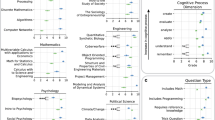
Perception, performance, and detectability of conversational artificial intelligence across 32 university courses
Hazem Ibrahim, Fengyuan Liu, … Yasir Zaki
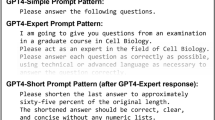
The model student: GPT-4 performance on graduate biomedical science exams
Daniel Stribling, Yuxing Xia, … Rolf Renne
Introduction
The massive uptake in the development and deployment of large-scale Natural Language Generation (NLG) systems in recent months has yielded an almost unprecedented worldwide discussion of the future of society. The ChatGPT service which serves as Web front-end to GPT-3.5 1 and GPT-4 was the fastest-growing service in history to break the 100 million user milestone in January and had 1 billion visits by February 2023 2 .
Driven by the upheaval that is particularly anticipated for education 3 and knowledge transfer for future generations, we conduct the first independent, systematic study of AI-generated language content that is typically dealt with in high-school education: argumentative essays, i.e. essays in which students discuss a position on a controversial topic by collecting and reflecting on evidence (e.g. ‘Should students be taught to cooperate or compete?’). Learning to write such essays is a crucial aspect of education, as students learn to systematically assess and reflect on a problem from different perspectives. Understanding the capability of generative AI to perform this task increases our understanding of the skills of the models, as well as of the challenges educators face when it comes to teaching this crucial skill. While there is a multitude of individual examples and anecdotal evidence for the quality of AI-generated content in this genre (e.g. 4 ) this paper is the first to systematically assess the quality of human-written and AI-generated argumentative texts across different versions of ChatGPT 5 . We use a fine-grained essay quality scoring rubric based on content and language mastery and employ a significant pool of domain experts, i.e. high school teachers across disciplines, to perform the evaluation. Using computational linguistic methods and rigorous statistical analysis, we arrive at several key findings:
AI models generate significantly higher-quality argumentative essays than the users of an essay-writing online forum frequented by German high-school students across all criteria in our scoring rubric.
ChatGPT-4 (ChatGPT web interface with the GPT-4 model) significantly outperforms ChatGPT-3 (ChatGPT web interface with the GPT-3.5 default model) with respect to logical structure, language complexity, vocabulary richness and text linking.
Writing styles between humans and generative AI models differ significantly: for instance, the GPT models use more nominalizations and have higher sentence complexity (signaling more complex, ‘scientific’, language), whereas the students make more use of modal and epistemic constructions (which tend to convey speaker attitude).
The linguistic diversity of the NLG models seems to be improving over time: while ChatGPT-3 still has a significantly lower linguistic diversity than humans, ChatGPT-4 has a significantly higher diversity than the students.
Our work goes significantly beyond existing benchmarks. While OpenAI’s technical report on GPT-4 6 presents some benchmarks, their evaluation lacks scientific rigor: it fails to provide vital information like the agreement between raters, does not report on details regarding the criteria for assessment or to what extent and how a statistical analysis was conducted for a larger sample of essays. In contrast, our benchmark provides the first (statistically) rigorous and systematic study of essay quality, paired with a computational linguistic analysis of the language employed by humans and two different versions of ChatGPT, offering a glance at how these NLG models develop over time. While our work is focused on argumentative essays in education, the genre is also relevant beyond education. In general, studying argumentative essays is one important aspect to understand how good generative AI models are at conveying arguments and, consequently, persuasive writing in general.
Related work
Natural language generation.
The recent interest in generative AI models can be largely attributed to the public release of ChatGPT, a public interface in the form of an interactive chat based on the InstructGPT 1 model, more commonly referred to as GPT-3.5. In comparison to the original GPT-3 7 and other similar generative large language models based on the transformer architecture like GPT-J 8 , this model was not trained in a purely self-supervised manner (e.g. through masked language modeling). Instead, a pipeline that involved human-written content was used to fine-tune the model and improve the quality of the outputs to both mitigate biases and safety issues, as well as make the generated text more similar to text written by humans. Such models are referred to as Fine-tuned LAnguage Nets (FLANs). For details on their training, we refer to the literature 9 . Notably, this process was recently reproduced with publicly available models such as Alpaca 10 and Dolly (i.e. the complete models can be downloaded and not just accessed through an API). However, we can only assume that a similar process was used for the training of GPT-4 since the paper by OpenAI does not include any details on model training.
Testing of the language competency of large-scale NLG systems has only recently started. Cai et al. 11 show that ChatGPT reuses sentence structure, accesses the intended meaning of an ambiguous word, and identifies the thematic structure of a verb and its arguments, replicating human language use. Mahowald 12 compares ChatGPT’s acceptability judgments to human judgments on the Article + Adjective + Numeral + Noun construction in English. Dentella et al. 13 show that ChatGPT-3 fails to understand low-frequent grammatical constructions like complex nested hierarchies and self-embeddings. In another recent line of research, the structure of automatically generated language is evaluated. Guo et al. 14 show that in question-answer scenarios, ChatGPT-3 uses different linguistic devices than humans. Zhao et al. 15 show that ChatGPT generates longer and more diverse responses when the user is in an apparently negative emotional state.
Given that we aim to identify certain linguistic characteristics of human-written versus AI-generated content, we also draw on related work in the field of linguistic fingerprinting, which assumes that each human has a unique way of using language to express themselves, i.e. the linguistic means that are employed to communicate thoughts, opinions and ideas differ between humans. That these properties can be identified with computational linguistic means has been showcased across different tasks: the computation of a linguistic fingerprint allows to distinguish authors of literary works 16 , the identification of speaker profiles in large public debates 17 , 18 , 19 , 20 and the provision of data for forensic voice comparison in broadcast debates 21 , 22 . For educational purposes, linguistic features are used to measure essay readability 23 , essay cohesion 24 and language performance scores for essay grading 25 . Integrating linguistic fingerprints also yields performance advantages for classification tasks, for instance in predicting user opinion 26 , 27 and identifying individual users 28 .
Limitations of OpenAIs ChatGPT evaluations
OpenAI published a discussion of the model’s performance of several tasks, including Advanced Placement (AP) classes within the US educational system 6 . The subjects used in performance evaluation are diverse and include arts, history, English literature, calculus, statistics, physics, chemistry, economics, and US politics. While the models achieved good or very good marks in most subjects, they did not perform well in English literature. GPT-3.5 also experienced problems with chemistry, macroeconomics, physics, and statistics. While the overall results are impressive, there are several significant issues: firstly, the conflict of interest of the model’s owners poses a problem for the performance interpretation. Secondly, there are issues with the soundness of the assessment beyond the conflict of interest, which make the generalizability of the results hard to assess with respect to the models’ capability to write essays. Notably, the AP exams combine multiple-choice questions with free-text answers. Only the aggregated scores are publicly available. To the best of our knowledge, neither the generated free-text answers, their overall assessment, nor their assessment given specific criteria from the used judgment rubric are published. Thirdly, while the paper states that 1–2 qualified third-party contractors participated in the rating of the free-text answers, it is unclear how often multiple ratings were generated for the same answer and what was the agreement between them. This lack of information hinders a scientifically sound judgement regarding the capabilities of these models in general, but also specifically for essays. Lastly, the owners of the model conducted their study in a few-shot prompt setting, where they gave the models a very structured template as well as an example of a human-written high-quality essay to guide the generation of the answers. This further fine-tuning of what the models generate could have also influenced the output. The results published by the owners go beyond the AP courses which are directly comparable to our work and also consider other student assessments like Graduate Record Examinations (GREs). However, these evaluations suffer from the same problems with the scientific rigor as the AP classes.
Scientific assessment of ChatGPT
Researchers across the globe are currently assessing the individual capabilities of these models with greater scientific rigor. We note that due to the recency and speed of these developments, the hereafter discussed literature has mostly only been published as pre-prints and has not yet been peer-reviewed. In addition to the above issues concretely related to the assessment of the capabilities to generate student essays, it is also worth noting that there are likely large problems with the trustworthiness of evaluations, because of data contamination, i.e. because the benchmark tasks are part of the training of the model, which enables memorization. For example, Aiyappa et al. 29 find evidence that this is likely the case for benchmark results regarding NLP tasks. This complicates the effort by researchers to assess the capabilities of the models beyond memorization.
Nevertheless, the first assessment results are already available – though mostly focused on ChatGPT-3 and not yet ChatGPT-4. Closest to our work is a study by Yeadon et al. 30 , who also investigate ChatGPT-3 performance when writing essays. They grade essays generated by ChatGPT-3 for five physics questions based on criteria that cover academic content, appreciation of the underlying physics, grasp of subject material, addressing the topic, and writing style. For each question, ten essays were generated and rated independently by five researchers. While the sample size precludes a statistical assessment, the results demonstrate that the AI model is capable of writing high-quality physics essays, but that the quality varies in a manner similar to human-written essays.
Guo et al. 14 create a set of free-text question answering tasks based on data they collected from the internet, e.g. question answering from Reddit. The authors then sample thirty triplets of a question, a human answer, and a ChatGPT-3 generated answer and ask human raters to assess if they can detect which was written by a human, and which was written by an AI. While this approach does not directly assess the quality of the output, it serves as a Turing test 31 designed to evaluate whether humans can distinguish between human- and AI-produced output. The results indicate that humans are in fact able to distinguish between the outputs when presented with a pair of answers. Humans familiar with ChatGPT are also able to identify over 80% of AI-generated answers without seeing a human answer in comparison. However, humans who are not yet familiar with ChatGPT-3 are not capable of identifying AI-written answers about 50% of the time. Moreover, the authors also find that the AI-generated outputs are deemed to be more helpful than the human answers in slightly more than half of the cases. This suggests that the strong results from OpenAI’s own benchmarks regarding the capabilities to generate free-text answers generalize beyond the benchmarks.
There are, however, some indicators that the benchmarks may be overly optimistic in their assessment of the model’s capabilities. For example, Kortemeyer 32 conducts a case study to assess how well ChatGPT-3 would perform in a physics class, simulating the tasks that students need to complete as part of the course: answer multiple-choice questions, do homework assignments, ask questions during a lesson, complete programming exercises, and write exams with free-text questions. Notably, ChatGPT-3 was allowed to interact with the instructor for many of the tasks, allowing for multiple attempts as well as feedback on preliminary solutions. The experiment shows that ChatGPT-3’s performance is in many aspects similar to that of the beginning learners and that the model makes similar mistakes, such as omitting units or simply plugging in results from equations. Overall, the AI would have passed the course with a low score of 1.5 out of 4.0. Similarly, Kung et al. 33 study the performance of ChatGPT-3 in the United States Medical Licensing Exam (USMLE) and find that the model performs at or near the passing threshold. Their assessment is a bit more optimistic than Kortemeyer’s as they state that this level of performance, comprehensible reasoning and valid clinical insights suggest that models such as ChatGPT may potentially assist human learning in clinical decision making.
Frieder et al. 34 evaluate the capabilities of ChatGPT-3 in solving graduate-level mathematical tasks. They find that while ChatGPT-3 seems to have some mathematical understanding, its level is well below that of an average student and in most cases is not sufficient to pass exams. Yuan et al. 35 consider the arithmetic abilities of language models, including ChatGPT-3 and ChatGPT-4. They find that they exhibit the best performance among other currently available language models (incl. Llama 36 , FLAN-T5 37 , and Bloom 38 ). However, the accuracy of basic arithmetic tasks is still only at 83% when considering correctness to the degree of \(10^{-3}\) , i.e. such models are still not capable of functioning reliably as calculators. In a slightly satiric, yet insightful take, Spencer et al. 39 assess how a scientific paper on gamma-ray astrophysics would look like, if it were written largely with the assistance of ChatGPT-3. They find that while the language capabilities are good and the model is capable of generating equations, the arguments are often flawed and the references to scientific literature are full of hallucinations.
The general reasoning skills of the models may also not be at the level expected from the benchmarks. For example, Cherian et al. 40 evaluate how well ChatGPT-3 performs on eleven puzzles that second graders should be able to solve and find that ChatGPT is only able to solve them on average in 36.4% of attempts, whereas the second graders achieve a mean of 60.4%. However, their sample size is very small and the problem was posed as a multiple-choice question answering problem, which cannot be directly compared to the NLG we consider.
Research gap
Within this article, we address an important part of the current research gap regarding the capabilities of ChatGPT (and similar technologies), guided by the following research questions:
RQ1: How good is ChatGPT based on GPT-3 and GPT-4 at writing argumentative student essays?
RQ2: How do AI-generated essays compare to essays written by students?
RQ3: What are linguistic devices that are characteristic of student versus AI-generated content?
We study these aspects with the help of a large group of teaching professionals who systematically assess a large corpus of student essays. To the best of our knowledge, this is the first large-scale, independent scientific assessment of ChatGPT (or similar models) of this kind. Answering these questions is crucial to understanding the impact of ChatGPT on the future of education.
Materials and methods
The essay topics originate from a corpus of argumentative essays in the field of argument mining 41 . Argumentative essays require students to think critically about a topic and use evidence to establish a position on the topic in a concise manner. The corpus features essays for 90 topics from Essay Forum 42 , an active community for providing writing feedback on different kinds of text and is frequented by high-school students to get feedback from native speakers on their essay-writing capabilities. Information about the age of the writers is not available, but the topics indicate that the essays were written in grades 11–13, indicating that the authors were likely at least 16. Topics range from ‘Should students be taught to cooperate or to compete?’ to ‘Will newspapers become a thing of the past?’. In the corpus, each topic features one human-written essay uploaded and discussed in the forum. The students who wrote the essays are not native speakers. The average length of these essays is 19 sentences with 388 tokens (an average of 2.089 characters) and will be termed ‘student essays’ in the remainder of the paper.
For the present study, we use the topics from Stab and Gurevych 41 and prompt ChatGPT with ‘Write an essay with about 200 words on “[ topic ]”’ to receive automatically-generated essays from the ChatGPT-3 and ChatGPT-4 versions from 22 March 2023 (‘ChatGPT-3 essays’, ‘ChatGPT-4 essays’). No additional prompts for getting the responses were used, i.e. the data was created with a basic prompt in a zero-shot scenario. This is in contrast to the benchmarks by OpenAI, who used an engineered prompt in a few-shot scenario to guide the generation of essays. We note that we decided to ask for 200 words because we noticed a tendency to generate essays that are longer than the desired length by ChatGPT. A prompt asking for 300 words typically yielded essays with more than 400 words. Thus, using the shorter length of 200, we prevent a potential advantage for ChatGPT through longer essays, and instead err on the side of brevity. Similar to the evaluations of free-text answers by OpenAI, we did not consider multiple configurations of the model due to the effort required to obtain human judgments. For the same reason, our data is restricted to ChatGPT and does not include other models available at that time, e.g. Alpaca. We use the browser versions of the tools because we consider this to be a more realistic scenario than using the API. Table 1 below shows the core statistics of the resulting dataset. Supplemental material S1 shows examples for essays from the data set.
Annotation study
Study participants.
The participants had registered for a two-hour online training entitled ‘ChatGPT – Challenges and Opportunities’ conducted by the authors of this paper as a means to provide teachers with some of the technological background of NLG systems in general and ChatGPT in particular. Only teachers permanently employed at secondary schools were allowed to register for this training. Focusing on these experts alone allows us to receive meaningful results as those participants have a wide range of experience in assessing students’ writing. A total of 139 teachers registered for the training, 129 of them teach at grammar schools, and only 10 teachers hold a position at other secondary schools. About half of the registered teachers (68 teachers) have been in service for many years and have successfully applied for promotion. For data protection reasons, we do not know the subject combinations of the registered teachers. We only know that a variety of subjects are represented, including languages (English, French and German), religion/ethics, and science. Supplemental material S5 provides some general information regarding German teacher qualifications.
The training began with an online lecture followed by a discussion phase. Teachers were given an overview of language models and basic information on how ChatGPT was developed. After about 45 minutes, the teachers received a both written and oral explanation of the questionnaire at the core of our study (see Supplementary material S3 ) and were informed that they had 30 minutes to finish the study tasks. The explanation included information on how the data was obtained, why we collect the self-assessment, and how we chose the criteria for the rating of the essays, the overall goal of our research, and a walk-through of the questionnaire. Participation in the questionnaire was voluntary and did not affect the awarding of a training certificate. We further informed participants that all data was collected anonymously and that we would have no way of identifying who participated in the questionnaire. We orally informed participants that they consent to the use of the provided ratings for our research by participating in the survey.
Once these instructions were provided orally and in writing, the link to the online form was given to the participants. The online form was running on a local server that did not log any information that could identify the participants (e.g. IP address) to ensure anonymity. As per instructions, consent for participation was given by using the online form. Due to the full anonymity, we could by definition not document who exactly provided the consent. This was implemented as further insurance that non-participation could not possibly affect being awarded the training certificate.
About 20% of the training participants did not take part in the questionnaire study, the remaining participants consented based on the information provided and participated in the rating of essays. After the questionnaire, we continued with an online lecture on the opportunities of using ChatGPT for teaching as well as AI beyond chatbots. The study protocol was reviewed and approved by the Research Ethics Committee of the University of Passau. We further confirm that our study protocol is in accordance with all relevant guidelines.
Questionnaire
The questionnaire consists of three parts: first, a brief self-assessment regarding the English skills of the participants which is based on the Common European Framework of Reference for Languages (CEFR) 43 . We have six levels ranging from ‘comparable to a native speaker’ to ‘some basic skills’ (see supplementary material S3 ). Then each participant was shown six essays. The participants were only shown the generated text and were not provided with information on whether the text was human-written or AI-generated.
The questionnaire covers the seven categories relevant for essay assessment shown below (for details see supplementary material S3 ):
Topic and completeness
Logic and composition
Expressiveness and comprehensiveness
Language mastery
Vocabulary and text linking
Language constructs
These categories are used as guidelines for essay assessment 44 established by the Ministry for Education of Lower Saxony, Germany. For each criterion, a seven-point Likert scale with scores from zero to six is defined, where zero is the worst score (e.g. no relation to the topic) and six is the best score (e.g. addressed the topic to a special degree). The questionnaire included a written description as guidance for the scoring.
After rating each essay, the participants were also asked to self-assess their confidence in the ratings. We used a five-point Likert scale based on the criteria for the self-assessment of peer-review scores from the Association for Computational Linguistics (ACL). Once a participant finished rating the six essays, they were shown a summary of their ratings, as well as the individual ratings for each of their essays and the information on how the essay was generated.
Computational linguistic analysis
In order to further explore and compare the quality of the essays written by students and ChatGPT, we consider the six following linguistic characteristics: lexical diversity, sentence complexity, nominalization, presence of modals, epistemic and discourse markers. Those are motivated by previous work: Weiss et al. 25 observe the correlation between measures of lexical, syntactic and discourse complexities to the essay gradings of German high-school examinations while McNamara et al. 45 explore cohesion (indicated, among other things, by connectives), syntactic complexity and lexical diversity in relation to the essay scoring.
Lexical diversity
We identify vocabulary richness by using a well-established measure of textual, lexical diversity (MTLD) 46 which is often used in the field of automated essay grading 25 , 45 , 47 . It takes into account the number of unique words but unlike the best-known measure of lexical diversity, the type-token ratio (TTR), it is not as sensitive to the difference in the length of the texts. In fact, Koizumi and In’nami 48 find it to be least affected by the differences in the length of the texts compared to some other measures of lexical diversity. This is relevant to us due to the difference in average length between the human-written and ChatGPT-generated essays.
Syntactic complexity
We use two measures in order to evaluate the syntactic complexity of the essays. One is based on the maximum depth of the sentence dependency tree which is produced using the spaCy 3.4.2 dependency parser 49 (‘Syntactic complexity (depth)’). For the second measure, we adopt an approach similar in nature to the one by Weiss et al. 25 who use clause structure to evaluate syntactic complexity. In our case, we count the number of conjuncts, clausal modifiers of nouns, adverbial clause modifiers, clausal complements, clausal subjects, and parataxes (‘Syntactic complexity (clauses)’). The supplementary material in S2 shows the difference between sentence complexity based on two examples from the data.
Nominalization is a common feature of a more scientific style of writing 50 and is used as an additional measure for syntactic complexity. In order to explore this feature, we count occurrences of nouns with suffixes such as ‘-ion’, ‘-ment’, ‘-ance’ and a few others which are known to transform verbs into nouns.
Semantic properties
Both modals and epistemic markers signal the commitment of the writer to their statement. We identify modals using the POS-tagging module provided by spaCy as well as a list of epistemic expressions of modality, such as ‘definitely’ and ‘potentially’, also used in other approaches to identifying semantic properties 51 . For epistemic markers we adopt an empirically-driven approach and utilize the epistemic markers identified in a corpus of dialogical argumentation by Hautli-Janisz et al. 52 . We consider expressions such as ‘I think’, ‘it is believed’ and ‘in my opinion’ to be epistemic.
Discourse properties
Discourse markers can be used to measure the coherence quality of a text. This has been explored by Somasundaran et al. 53 who use discourse markers to evaluate the story-telling aspect of student writing while Nadeem et al. 54 incorporated them in their deep learning-based approach to automated essay scoring. In the present paper, we employ the PDTB list of discourse markers 55 which we adjust to exclude words that are often used for purposes other than indicating discourse relations, such as ‘like’, ‘for’, ‘in’ etc.
Statistical methods
We use a within-subjects design for our study. Each participant was shown six randomly selected essays. Results were submitted to the survey system after each essay was completed, in case participants ran out of time and did not finish scoring all six essays. Cronbach’s \(\alpha\) 56 allows us to determine the inter-rater reliability for the rating criterion and data source (human, ChatGPT-3, ChatGPT-4) in order to understand the reliability of our data not only overall, but also for each data source and rating criterion. We use two-sided Wilcoxon-rank-sum tests 57 to confirm the significance of the differences between the data sources for each criterion. We use the same tests to determine the significance of the linguistic characteristics. This results in three comparisons (human vs. ChatGPT-3, human vs. ChatGPT-4, ChatGPT-3 vs. ChatGPT-4) for each of the seven rating criteria and each of the seven linguistic characteristics, i.e. 42 tests. We use the Holm-Bonferroni method 58 for the correction for multiple tests to achieve a family-wise error rate of 0.05. We report the effect size using Cohen’s d 59 . While our data is not perfectly normal, it also does not have severe outliers, so we prefer the clear interpretation of Cohen’s d over the slightly more appropriate, but less accessible non-parametric effect size measures. We report point plots with estimates of the mean scores for each data source and criterion, incl. the 95% confidence interval of these mean values. The confidence intervals are estimated in a non-parametric manner based on bootstrap sampling. We further visualize the distribution for each criterion using violin plots to provide a visual indicator of the spread of the data (see Supplementary material S4 ).
Further, we use the self-assessment of the English skills and confidence in the essay ratings as confounding variables. Through this, we determine if ratings are affected by the language skills or confidence, instead of the actual quality of the essays. We control for the impact of these by measuring Pearson’s correlation coefficient r 60 between the self-assessments and the ratings. We also determine whether the linguistic features are correlated with the ratings as expected. The sentence complexity (both tree depth and dependency clauses), as well as the nominalization, are indicators of the complexity of the language. Similarly, the use of discourse markers should signal a proper logical structure. Finally, a large lexical diversity should be correlated with the ratings for the vocabulary. Same as above, we measure Pearson’s r . We use a two-sided test for the significance based on a \(\beta\) -distribution that models the expected correlations as implemented by scipy 61 . Same as above, we use the Holm-Bonferroni method to account for multiple tests. However, we note that it is likely that all—even tiny—correlations are significant given our amount of data. Consequently, our interpretation of these results focuses on the strength of the correlations.
Our statistical analysis of the data is implemented in Python. We use pandas 1.5.3 and numpy 1.24.2 for the processing of data, pingouin 0.5.3 for the calculation of Cronbach’s \(\alpha\) , scipy 1.10.1 for the Wilcoxon-rank-sum tests Pearson’s r , and seaborn 0.12.2 for the generation of plots, incl. the calculation of error bars that visualize the confidence intervals.
Out of the 111 teachers who completed the questionnaire, 108 rated all six essays, one rated five essays, one rated two essays, and one rated only one essay. This results in 658 ratings for 270 essays (90 topics for each essay type: human-, ChatGPT-3-, ChatGPT-4-generated), with three ratings for 121 essays, two ratings for 144 essays, and one rating for five essays. The inter-rater agreement is consistently excellent ( \(\alpha >0.9\) ), with the exception of language mastery where we have good agreement ( \(\alpha =0.89\) , see Table 2 ). Further, the correlation analysis depicted in supplementary material S4 shows weak positive correlations ( \(r \in 0.11, 0.28]\) ) between the self-assessment for the English skills, respectively the self-assessment for the confidence in ratings and the actual ratings. Overall, this indicates that our ratings are reliable estimates of the actual quality of the essays with a potential small tendency that confidence in ratings and language skills yields better ratings, independent of the data source.
Table 2 and supplementary material S4 characterize the distribution of the ratings for the essays, grouped by the data source. We observe that for all criteria, we have a clear order of the mean values, with students having the worst ratings, ChatGPT-3 in the middle rank, and ChatGPT-4 with the best performance. We further observe that the standard deviations are fairly consistent and slightly larger than one, i.e. the spread is similar for all ratings and essays. This is further supported by the visual analysis of the violin plots.
The statistical analysis of the ratings reported in Table 4 shows that differences between the human-written essays and the ones generated by both ChatGPT models are significant. The effect sizes for human versus ChatGPT-3 essays are between 0.52 and 1.15, i.e. a medium ( \(d \in [0.5,0.8)\) ) to large ( \(d \in [0.8, 1.2)\) ) effect. On the one hand, the smallest effects are observed for the expressiveness and complexity, i.e. when it comes to the overall comprehensiveness and complexity of the sentence structures, the differences between the humans and the ChatGPT-3 model are smallest. On the other hand, the difference in language mastery is larger than all other differences, which indicates that humans are more prone to making mistakes when writing than the NLG models. The magnitude of differences between humans and ChatGPT-4 is larger with effect sizes between 0.88 and 1.43, i.e., a large to very large ( \(d \in [1.2, 2)\) ) effect. Same as for ChatGPT-3, the differences are smallest for expressiveness and complexity and largest for language mastery. Please note that the difference in language mastery between humans and both GPT models does not mean that the humans have low scores for language mastery (M=3.90), but rather that the NLG models have exceptionally high scores (M=5.03 for ChatGPT-3, M=5.25 for ChatGPT-4).
When we consider the differences between the two GPT models, we observe that while ChatGPT-4 has consistently higher mean values for all criteria, only the differences for logic and composition, vocabulary and text linking, and complexity are significant. The effect sizes are between 0.45 and 0.5, i.e. small ( \(d \in [0.2, 0.5)\) ) and medium. Thus, while GPT-4 seems to be an improvement over GPT-3.5 in general, the only clear indicator of this is a better and clearer logical composition and more complex writing with a more diverse vocabulary.
We also observe significant differences in the distribution of linguistic characteristics between all three groups (see Table 3 ). Sentence complexity (depth) is the only category without a significant difference between humans and ChatGPT-3, as well as ChatGPT-3 and ChatGPT-4. There is also no significant difference in the category of discourse markers between humans and ChatGPT-3. The magnitude of the effects varies a lot and is between 0.39 and 1.93, i.e., between small ( \(d \in [0.2, 0.5)\) ) and very large. However, in comparison to the ratings, there is no clear tendency regarding the direction of the differences. For instance, while the ChatGPT models write more complex sentences and use more nominalizations, humans tend to use more modals and epistemic markers instead. The lexical diversity of humans is higher than that of ChatGPT-3 but lower than that of ChatGPT-4. While there is no difference in the use of discourse markers between humans and ChatGPT-3, ChatGPT-4 uses significantly fewer discourse markers.
We detect the expected positive correlations between the complexity ratings and the linguistic markers for sentence complexity ( \(r=0.16\) for depth, \(r=0.19\) for clauses) and nominalizations ( \(r=0.22\) ). However, we observe a negative correlation between the logic ratings and the discourse markers ( \(r=-0.14\) ), which counters our intuition that more frequent use of discourse indicators makes a text more logically coherent. However, this is in line with previous work: McNamara et al. 45 also find no indication that the use of cohesion indices such as discourse connectives correlates with high- and low-proficiency essays. Finally, we observe the expected positive correlation between the ratings for the vocabulary and the lexical diversity ( \(r=0.12\) ). All observed correlations are significant. However, we note that the strength of all these correlations is weak and that the significance itself should not be over-interpreted due to the large sample size.
Our results provide clear answers to the first two research questions that consider the quality of the generated essays: ChatGPT performs well at writing argumentative student essays and outperforms the quality of the human-written essays significantly. The ChatGPT-4 model has (at least) a large effect and is on average about one point better than humans on a seven-point Likert scale.
Regarding the third research question, we find that there are significant linguistic differences between humans and AI-generated content. The AI-generated essays are highly structured, which for instance is reflected by the identical beginnings of the concluding sections of all ChatGPT essays (‘In conclusion, [...]’). The initial sentences of each essay are also very similar starting with a general statement using the main concepts of the essay topics. Although this corresponds to the general structure that is sought after for argumentative essays, it is striking to see that the ChatGPT models are so rigid in realizing this, whereas the human-written essays are looser in representing the guideline on the linguistic surface. Moreover, the linguistic fingerprint has the counter-intuitive property that the use of discourse markers is negatively correlated with logical coherence. We believe that this might be due to the rigid structure of the generated essays: instead of using discourse markers, the AI models provide a clear logical structure by separating the different arguments into paragraphs, thereby reducing the need for discourse markers.
Our data also shows that hallucinations are not a problem in the setting of argumentative essay writing: the essay topics are not really about factual correctness, but rather about argumentation and critical reflection on general concepts which seem to be contained within the knowledge of the AI model. The stochastic nature of the language generation is well-suited for this kind of task, as different plausible arguments can be seen as a sampling from all available arguments for a topic. Nevertheless, we need to perform a more systematic study of the argumentative structures in order to better understand the difference in argumentation between human-written and ChatGPT-generated essay content. Moreover, we also cannot rule out that subtle hallucinations may have been overlooked during the ratings. There are also essays with a low rating for the criteria related to factual correctness, indicating that there might be cases where the AI models still have problems, even if they are, on average, better than the students.
One of the issues with evaluations of the recent large-language models is not accounting for the impact of tainted data when benchmarking such models. While it is certainly possible that the essays that were sourced by Stab and Gurevych 41 from the internet were part of the training data of the GPT models, the proprietary nature of the model training means that we cannot confirm this. However, we note that the generated essays did not resemble the corpus of human essays at all. Moreover, the topics of the essays are general in the sense that any human should be able to reason and write about these topics, just by understanding concepts like ‘cooperation’. Consequently, a taint on these general topics, i.e. the fact that they might be present in the data, is not only possible but is actually expected and unproblematic, as it relates to the capability of the models to learn about concepts, rather than the memorization of specific task solutions.
While we did everything to ensure a sound construct and a high validity of our study, there are still certain issues that may affect our conclusions. Most importantly, neither the writers of the essays, nor their raters, were English native speakers. However, the students purposefully used a forum for English writing frequented by native speakers to ensure the language and content quality of their essays. This indicates that the resulting essays are likely above average for non-native speakers, as they went through at least one round of revisions with the help of native speakers. The teachers were informed that part of the training would be in English to prevent registrations from people without English language skills. Moreover, the self-assessment of the language skills was only weakly correlated with the ratings, indicating that the threat to the soundness of our results is low. While we cannot definitively rule out that our results would not be reproducible with other human raters, the high inter-rater agreement indicates that this is unlikely.
However, our reliance on essays written by non-native speakers affects the external validity and the generalizability of our results. It is certainly possible that native speaking students would perform better in the criteria related to language skills, though it is unclear by how much. However, the language skills were particular strengths of the AI models, meaning that while the difference might be smaller, it is still reasonable to conclude that the AI models would have at least comparable performance to humans, but possibly still better performance, just with a smaller gap. While we cannot rule out a difference for the content-related criteria, we also see no strong argument why native speakers should have better arguments than non-native speakers. Thus, while our results might not fully translate to native speakers, we see no reason why aspects regarding the content should not be similar. Further, our results were obtained based on high-school-level essays. Native and non-native speakers with higher education degrees or experts in fields would likely also achieve a better performance, such that the difference in performance between the AI models and humans would likely also be smaller in such a setting.
We further note that the essay topics may not be an unbiased sample. While Stab and Gurevych 41 randomly sampled the essays from the writing feedback section of an essay forum, it is unclear whether the essays posted there are representative of the general population of essay topics. Nevertheless, we believe that the threat is fairly low because our results are consistent and do not seem to be influenced by certain topics. Further, we cannot with certainty conclude how our results generalize beyond ChatGPT-3 and ChatGPT-4 to similar models like Bard ( https://bard.google.com/?hl=en ) Alpaca, and Dolly. Especially the results for linguistic characteristics are hard to predict. However, since—to the best of our knowledge and given the proprietary nature of some of these models—the general approach to how these models work is similar and the trends for essay quality should hold for models with comparable size and training procedures.
Finally, we want to note that the current speed of progress with generative AI is extremely fast and we are studying moving targets: ChatGPT 3.5 and 4 today are already not the same as the models we studied. Due to a lack of transparency regarding the specific incremental changes, we cannot know or predict how this might affect our results.
Our results provide a strong indication that the fear many teaching professionals have is warranted: the way students do homework and teachers assess it needs to change in a world of generative AI models. For non-native speakers, our results show that when students want to maximize their essay grades, they could easily do so by relying on results from AI models like ChatGPT. The very strong performance of the AI models indicates that this might also be the case for native speakers, though the difference in language skills is probably smaller. However, this is not and cannot be the goal of education. Consequently, educators need to change how they approach homework. Instead of just assigning and grading essays, we need to reflect more on the output of AI tools regarding their reasoning and correctness. AI models need to be seen as an integral part of education, but one which requires careful reflection and training of critical thinking skills.
Furthermore, teachers need to adapt strategies for teaching writing skills: as with the use of calculators, it is necessary to critically reflect with the students on when and how to use those tools. For instance, constructivists 62 argue that learning is enhanced by the active design and creation of unique artifacts by students themselves. In the present case this means that, in the long term, educational objectives may need to be adjusted. This is analogous to teaching good arithmetic skills to younger students and then allowing and encouraging students to use calculators freely in later stages of education. Similarly, once a sound level of literacy has been achieved, strongly integrating AI models in lesson plans may no longer run counter to reasonable learning goals.
In terms of shedding light on the quality and structure of AI-generated essays, this paper makes an important contribution by offering an independent, large-scale and statistically sound account of essay quality, comparing human-written and AI-generated texts. By comparing different versions of ChatGPT, we also offer a glance into the development of these models over time in terms of their linguistic properties and the quality they exhibit. Our results show that while the language generated by ChatGPT is considered very good by humans, there are also notable structural differences, e.g. in the use of discourse markers. This demonstrates that an in-depth consideration not only of the capabilities of generative AI models is required (i.e. which tasks can they be used for), but also of the language they generate. For example, if we read many AI-generated texts that use fewer discourse markers, it raises the question if and how this would affect our human use of discourse markers. Understanding how AI-generated texts differ from human-written enables us to look for these differences, to reason about their potential impact, and to study and possibly mitigate this impact.
Data availability
The datasets generated during and/or analysed during the current study are available in the Zenodo repository, https://doi.org/10.5281/zenodo.8343644
Code availability
All materials are available online in form of a replication package that contains the data and the analysis code, https://doi.org/10.5281/zenodo.8343644 .
Ouyang, L. et al. Training language models to follow instructions with human feedback (2022). arXiv:2203.02155 .
Ruby, D. 30+ detailed chatgpt statistics–users & facts (sep 2023). https://www.demandsage.com/chatgpt-statistics/ (2023). Accessed 09 June 2023.
Leahy, S. & Mishra, P. TPACK and the Cambrian explosion of AI. In Society for Information Technology & Teacher Education International Conference , (ed. Langran, E.) 2465–2469 (Association for the Advancement of Computing in Education (AACE), 2023).
Ortiz, S. Need an ai essay writer? here’s how chatgpt (and other chatbots) can help. https://www.zdnet.com/article/how-to-use-chatgpt-to-write-an-essay/ (2023). Accessed 09 June 2023.
Openai chat interface. https://chat.openai.com/ . Accessed 09 June 2023.
OpenAI. Gpt-4 technical report (2023). arXiv:2303.08774 .
Brown, T. B. et al. Language models are few-shot learners (2020). arXiv:2005.14165 .
Wang, B. Mesh-Transformer-JAX: Model-Parallel Implementation of Transformer Language Model with JAX. https://github.com/kingoflolz/mesh-transformer-jax (2021).
Wei, J. et al. Finetuned language models are zero-shot learners. In International Conference on Learning Representations (2022).
Taori, R. et al. Stanford alpaca: An instruction-following llama model. https://github.com/tatsu-lab/stanford_alpaca (2023).
Cai, Z. G., Haslett, D. A., Duan, X., Wang, S. & Pickering, M. J. Does chatgpt resemble humans in language use? (2023). arXiv:2303.08014 .
Mahowald, K. A discerning several thousand judgments: Gpt-3 rates the article + adjective + numeral + noun construction (2023). arXiv:2301.12564 .
Dentella, V., Murphy, E., Marcus, G. & Leivada, E. Testing ai performance on less frequent aspects of language reveals insensitivity to underlying meaning (2023). arXiv:2302.12313 .
Guo, B. et al. How close is chatgpt to human experts? comparison corpus, evaluation, and detection (2023). arXiv:2301.07597 .
Zhao, W. et al. Is chatgpt equipped with emotional dialogue capabilities? (2023). arXiv:2304.09582 .
Keim, D. A. & Oelke, D. Literature fingerprinting : A new method for visual literary analysis. In 2007 IEEE Symposium on Visual Analytics Science and Technology , 115–122, https://doi.org/10.1109/VAST.2007.4389004 (IEEE, 2007).
El-Assady, M. et al. Interactive visual analysis of transcribed multi-party discourse. In Proceedings of ACL 2017, System Demonstrations , 49–54 (Association for Computational Linguistics, Vancouver, Canada, 2017).
Mennatallah El-Assady, A. H.-J. & Butt, M. Discourse maps - feature encoding for the analysis of verbatim conversation transcripts. In Visual Analytics for Linguistics , vol. CSLI Lecture Notes, Number 220, 115–147 (Stanford: CSLI Publications, 2020).
Matt Foulis, J. V. & Reed, C. Dialogical fingerprinting of debaters. In Proceedings of COMMA 2020 , 465–466, https://doi.org/10.3233/FAIA200536 (Amsterdam: IOS Press, 2020).
Matt Foulis, J. V. & Reed, C. Interactive visualisation of debater identification and characteristics. In Proceedings of the COMMA workshop on Argument Visualisation, COMMA , 1–7 (2020).
Chatzipanagiotidis, S., Giagkou, M. & Meurers, D. Broad linguistic complexity analysis for Greek readability classification. In Proceedings of the 16th Workshop on Innovative Use of NLP for Building Educational Applications , 48–58 (Association for Computational Linguistics, Online, 2021).
Ajili, M., Bonastre, J.-F., Kahn, J., Rossato, S. & Bernard, G. FABIOLE, a speech database for forensic speaker comparison. In Proceedings of the Tenth International Conference on Language Resources and Evaluation (LREC’16) , 726–733 (European Language Resources Association (ELRA), Portorož, Slovenia, 2016).
Deutsch, T., Jasbi, M. & Shieber, S. Linguistic features for readability assessment. In Proceedings of the Fifteenth Workshop on Innovative Use of NLP for Building Educational Applications , 1–17, https://doi.org/10.18653/v1/2020.bea-1.1 (Association for Computational Linguistics, Seattle, WA, USA \(\rightarrow\) Online, 2020).
Fiacco, J., Jiang, S., Adamson, D. & Rosé, C. Toward automatic discourse parsing of student writing motivated by neural interpretation. In Proceedings of the 17th Workshop on Innovative Use of NLP for Building Educational Applications (BEA 2022) , 204–215, https://doi.org/10.18653/v1/2022.bea-1.25 (Association for Computational Linguistics, Seattle, Washington, 2022).
Weiss, Z., Riemenschneider, A., Schröter, P. & Meurers, D. Computationally modeling the impact of task-appropriate language complexity and accuracy on human grading of German essays. In Proceedings of the Fourteenth Workshop on Innovative Use of NLP for Building Educational Applications , 30–45, https://doi.org/10.18653/v1/W19-4404 (Association for Computational Linguistics, Florence, Italy, 2019).
Yang, F., Dragut, E. & Mukherjee, A. Predicting personal opinion on future events with fingerprints. In Proceedings of the 28th International Conference on Computational Linguistics , 1802–1807, https://doi.org/10.18653/v1/2020.coling-main.162 (International Committee on Computational Linguistics, Barcelona, Spain (Online), 2020).
Tumarada, K. et al. Opinion prediction with user fingerprinting. In Proceedings of the International Conference on Recent Advances in Natural Language Processing (RANLP 2021) , 1423–1431 (INCOMA Ltd., Held Online, 2021).
Rocca, R. & Yarkoni, T. Language as a fingerprint: Self-supervised learning of user encodings using transformers. In Findings of the Association for Computational Linguistics: EMNLP . 1701–1714 (Association for Computational Linguistics, Abu Dhabi, United Arab Emirates, 2022).
Aiyappa, R., An, J., Kwak, H. & Ahn, Y.-Y. Can we trust the evaluation on chatgpt? (2023). arXiv:2303.12767 .
Yeadon, W., Inyang, O.-O., Mizouri, A., Peach, A. & Testrow, C. The death of the short-form physics essay in the coming ai revolution (2022). arXiv:2212.11661 .
TURING, A. M. I.-COMPUTING MACHINERY AND INTELLIGENCE. Mind LIX , 433–460, https://doi.org/10.1093/mind/LIX.236.433 (1950). https://academic.oup.com/mind/article-pdf/LIX/236/433/30123314/lix-236-433.pdf .
Kortemeyer, G. Could an artificial-intelligence agent pass an introductory physics course? (2023). arXiv:2301.12127 .
Kung, T. H. et al. Performance of chatgpt on usmle: Potential for ai-assisted medical education using large language models. PLOS Digital Health 2 , 1–12. https://doi.org/10.1371/journal.pdig.0000198 (2023).
Article Google Scholar
Frieder, S. et al. Mathematical capabilities of chatgpt (2023). arXiv:2301.13867 .
Yuan, Z., Yuan, H., Tan, C., Wang, W. & Huang, S. How well do large language models perform in arithmetic tasks? (2023). arXiv:2304.02015 .
Touvron, H. et al. Llama: Open and efficient foundation language models (2023). arXiv:2302.13971 .
Chung, H. W. et al. Scaling instruction-finetuned language models (2022). arXiv:2210.11416 .
Workshop, B. et al. Bloom: A 176b-parameter open-access multilingual language model (2023). arXiv:2211.05100 .
Spencer, S. T., Joshi, V. & Mitchell, A. M. W. Can ai put gamma-ray astrophysicists out of a job? (2023). arXiv:2303.17853 .
Cherian, A., Peng, K.-C., Lohit, S., Smith, K. & Tenenbaum, J. B. Are deep neural networks smarter than second graders? (2023). arXiv:2212.09993 .
Stab, C. & Gurevych, I. Annotating argument components and relations in persuasive essays. In Proceedings of COLING 2014, the 25th International Conference on Computational Linguistics: Technical Papers , 1501–1510 (Dublin City University and Association for Computational Linguistics, Dublin, Ireland, 2014).
Essay forum. https://essayforum.com/ . Last-accessed: 2023-09-07.
Common european framework of reference for languages (cefr). https://www.coe.int/en/web/common-european-framework-reference-languages . Accessed 09 July 2023.
Kmk guidelines for essay assessment. http://www.kmk-format.de/material/Fremdsprachen/5-3-2_Bewertungsskalen_Schreiben.pdf . Accessed 09 July 2023.
McNamara, D. S., Crossley, S. A. & McCarthy, P. M. Linguistic features of writing quality. Writ. Commun. 27 , 57–86 (2010).
McCarthy, P. M. & Jarvis, S. Mtld, vocd-d, and hd-d: A validation study of sophisticated approaches to lexical diversity assessment. Behav. Res. Methods 42 , 381–392 (2010).
Article PubMed Google Scholar
Dasgupta, T., Naskar, A., Dey, L. & Saha, R. Augmenting textual qualitative features in deep convolution recurrent neural network for automatic essay scoring. In Proceedings of the 5th Workshop on Natural Language Processing Techniques for Educational Applications , 93–102 (2018).
Koizumi, R. & In’nami, Y. Effects of text length on lexical diversity measures: Using short texts with less than 200 tokens. System 40 , 554–564 (2012).
spacy industrial-strength natural language processing in python. https://spacy.io/ .
Siskou, W., Friedrich, L., Eckhard, S., Espinoza, I. & Hautli-Janisz, A. Measuring plain language in public service encounters. In Proceedings of the 2nd Workshop on Computational Linguistics for Political Text Analysis (CPSS-2022) (Potsdam, Germany, 2022).
El-Assady, M. & Hautli-Janisz, A. Discourse Maps - Feature Encoding for the Analysis of Verbatim Conversation Transcripts (CSLI lecture notes (CSLI Publications, Center for the Study of Language and Information, 2019).
Hautli-Janisz, A. et al. QT30: A corpus of argument and conflict in broadcast debate. In Proceedings of the Thirteenth Language Resources and Evaluation Conference , 3291–3300 (European Language Resources Association, Marseille, France, 2022).
Somasundaran, S. et al. Towards evaluating narrative quality in student writing. Trans. Assoc. Comput. Linguist. 6 , 91–106 (2018).
Nadeem, F., Nguyen, H., Liu, Y. & Ostendorf, M. Automated essay scoring with discourse-aware neural models. In Proceedings of the Fourteenth Workshop on Innovative Use of NLP for Building Educational Applications , 484–493, https://doi.org/10.18653/v1/W19-4450 (Association for Computational Linguistics, Florence, Italy, 2019).
Prasad, R. et al. The Penn Discourse TreeBank 2.0. In Proceedings of the Sixth International Conference on Language Resources and Evaluation (LREC’08) (European Language Resources Association (ELRA), Marrakech, Morocco, 2008).
Cronbach, L. J. Coefficient alpha and the internal structure of tests. Psychometrika 16 , 297–334. https://doi.org/10.1007/bf02310555 (1951).
Article MATH Google Scholar
Wilcoxon, F. Individual comparisons by ranking methods. Biom. Bull. 1 , 80–83 (1945).
Holm, S. A simple sequentially rejective multiple test procedure. Scand. J. Stat. 6 , 65–70 (1979).
MathSciNet MATH Google Scholar
Cohen, J. Statistical power analysis for the behavioral sciences (Academic press, 2013).
Freedman, D., Pisani, R. & Purves, R. Statistics (international student edition). Pisani, R. Purves, 4th edn. WW Norton & Company, New York (2007).
Scipy documentation. https://docs.scipy.org/doc/scipy/reference/generated/scipy.stats.pearsonr.html . Accessed 09 June 2023.
Windschitl, M. Framing constructivism in practice as the negotiation of dilemmas: An analysis of the conceptual, pedagogical, cultural, and political challenges facing teachers. Rev. Educ. Res. 72 , 131–175 (2002).
Download references
Open Access funding enabled and organized by Projekt DEAL.
Author information
Authors and affiliations.
Faculty of Computer Science and Mathematics, University of Passau, Passau, Germany
Steffen Herbold, Annette Hautli-Janisz, Ute Heuer, Zlata Kikteva & Alexander Trautsch
You can also search for this author in PubMed Google Scholar
Contributions
S.H., A.HJ., and U.H. conceived the experiment; S.H., A.HJ, and Z.K. collected the essays from ChatGPT; U.H. recruited the study participants; S.H., A.HJ., U.H. and A.T. conducted the training session and questionnaire; all authors contributed to the analysis of the results, the writing of the manuscript, and review of the manuscript.
Corresponding author
Correspondence to Steffen Herbold .
Ethics declarations
Competing interests.
The authors declare no competing interests.
Additional information
Publisher's note.
Springer Nature remains neutral with regard to jurisdictional claims in published maps and institutional affiliations.
Supplementary Information
Supplementary information 1., supplementary information 2., supplementary information 3., supplementary tables., supplementary figures., rights and permissions.
Open Access This article is licensed under a Creative Commons Attribution 4.0 International License, which permits use, sharing, adaptation, distribution and reproduction in any medium or format, as long as you give appropriate credit to the original author(s) and the source, provide a link to the Creative Commons licence, and indicate if changes were made. The images or other third party material in this article are included in the article's Creative Commons licence, unless indicated otherwise in a credit line to the material. If material is not included in the article's Creative Commons licence and your intended use is not permitted by statutory regulation or exceeds the permitted use, you will need to obtain permission directly from the copyright holder. To view a copy of this licence, visit http://creativecommons.org/licenses/by/4.0/ .
Reprints and permissions
About this article
Cite this article.
Herbold, S., Hautli-Janisz, A., Heuer, U. et al. A large-scale comparison of human-written versus ChatGPT-generated essays. Sci Rep 13 , 18617 (2023). https://doi.org/10.1038/s41598-023-45644-9
Download citation
Received : 01 June 2023
Accepted : 22 October 2023
Published : 30 October 2023
DOI : https://doi.org/10.1038/s41598-023-45644-9
Share this article
Anyone you share the following link with will be able to read this content:
Sorry, a shareable link is not currently available for this article.
Provided by the Springer Nature SharedIt content-sharing initiative
This article is cited by
Defense against adversarial attacks: robust and efficient compressed optimized neural networks.
- Insaf Kraidia
- Afifa Ghenai
- Samir Brahim Belhaouari
Scientific Reports (2024)
AI-driven translations for kidney transplant equity in Hispanic populations
- Oscar A. Garcia Valencia
- Charat Thongprayoon
- Wisit Cheungpasitporn
How will the state think with ChatGPT? The challenges of generative artificial intelligence for public administrations
- Thomas Cantens
AI & SOCIETY (2024)
By submitting a comment you agree to abide by our Terms and Community Guidelines . If you find something abusive or that does not comply with our terms or guidelines please flag it as inappropriate.
Quick links
- Explore articles by subject
- Guide to authors
- Editorial policies
Sign up for the Nature Briefing: AI and Robotics newsletter — what matters in AI and robotics research, free to your inbox weekly.
- Link to facebook
- Link to linkedin
- Link to twitter
- Link to youtube
- Writing Tips
Tips for Writing a Compare and Contrast Essay

- 5-minute read
- 19th August 2022
Compare and contrast essays are a specific form of academic essay with unique requirements, so if you’re a student , it’s important that you to know how to write one. Luckily, we’ve pieced together this guide to help you plan, structure, and put together your essay, complete with tips for comparing and contrasting.
Let’s begin.
1. What Is a Compare and Contrast Essay?
As you may have guessed, when writing a compare and contrast essay, you’ll need to do two things:
- Compare the similarities between two or more given subjects.
- Contrast their differences.
Compare and contrast essays are a common essay style because they allow your teacher or lecturer to assess your understanding of two theories, research methods, literary techniques, or other subjects. These subjects are usually related and may sometimes be confused with one another or are in conflict with each other.
By comparing and contrasting the subjects, you can also improve your analysis skills .
Some examples of compare and contrast essay titles include:
Compare and contrast a Shakespearean sonnet with a Petrarchan sonnet. What are the similarities and differences between anabolic and catabolic reactions? How were Nehru’s political beliefs similar to Gandhi’s? How did they differ?
2. Planning a Compare and Contrast Essay
As with any essay, before you begin writing, you should have a plan . In this case, you’ll first need to identify the similarities and differences between your subjects.
You can do this by writing out a list of all the qualities each subject possesses. Then, you can pick out any similar qualities that show up in both lists, and any qualities that are unique to just one of them. If you’re a visual learner, you might want to draw this as a Venn diagram .
Once you have all the similarities and differences prepared, consider which of them will be the most useful to include in your essay. Ask yourself:
- How much can you write about each point?
- What will your conclusion be, and which points support it?
- How will each point fit into your essay’s structure?
To answer that last question, let’s take a look at some ways to structure your essay.
Find this useful?
Subscribe to our newsletter and get writing tips from our editors straight to your inbox.
3. Structuring a Compare and Contrast Essay
Now that you’ve got a plan for your essay, it’s time to organize it. There are three main structures you can follow when writing a compare and contrast essay:
- The block structure: All of the information about one subject (e.g., Shakespearean sonnets) is presented in the first few paragraphs, followed by the subject it’s being compared and contrasted with (e.g., Petrarchan sonnets).
- The alternating structure: One similarity or difference between both subjects (e.g., rhyme scheme) is explored in one paragraph, followed by a paragraph on another similarity or difference (e.g., use of imagery), and so on.
- The similarities and differences structure: All the similarities between both subjects are presented, followed by the differences.
There are benefits to each of these structures. The block structure, for example, can be easier to write, while the alternating structure presents each similarity and difference clearly, and the similarities and differences structure focuses on those points rather than the subjects themselves.
So, when deciding which structure to use, consider what would work best for your essay. If you intend to cover each subject in detail, for example, you might want to choose the block structure.
On the other hand, if you want to emphasize the connections between each subject, the alternating structure might be best.
Finally, if you want to conclude that the subjects are either overwhelmingly similar or different to each other, the similarities and differences structure may work in your favor.
Whichever structure you follow, though, you’ll need to include a strong introduction and conclusion.
Your introduction should:
- Establish the subjects you will be comparing and contrasting.
- Provide some background about their connection (e.g., “Shakespearean and Petrarchan sonnets are poetic forms common in the 14th to 19th centuries”).
- Explain what you aim to achieve with your essay.
Meanwhile, your conclusion should:
- Summarize the main similarities and differences you have identified.
- Make a point regarding the relationship between your subjects.
4. Things to Remember
Here are some important tips to keep in mind when writing your compare and contrast essay:
- Ensure you are comparing or contrasting the same criteria between each subject. For example, it wouldn’t make sense to compare the line length of a Shakespearean sonnet with the rhyme scheme of a Petrarchan sonnet, as these are two separate categories.
- Always address both subjects of your essay in any introductions, conclusions, and topic sentences.
- Use comparison words and phrases such as “similarly,” “like,” and “in the same way” when comparing subjects.
- Use contrast words and phrases such as “in contrast,” “however,” and “whereas” when contrasting subjects.
- As with any essay, make sure to back up any arguments you make with evidence and credible sources .
Expert Academic Proofreading
Once you’ve written your compare and contrast essay, don’t forget to have it proofread. Our dedicated essay editing team is available 24/7 to help polish your paper. Try us out with a free proofreading and editing sample .
Share this article:
Post A New Comment
Got content that needs a quick turnaround? Let us polish your work. Explore our editorial business services.
3-minute read
What Is a Content Editor?
Are you interested in learning more about the role of a content editor and the...
4-minute read
The Benefits of Using an Online Proofreading Service
Proofreading is important to ensure your writing is clear and concise for your readers. Whether...
2-minute read
6 Online AI Presentation Maker Tools
Creating presentations can be time-consuming and frustrating. Trying to construct a visually appealing and informative...
What Is Market Research?
No matter your industry, conducting market research helps you keep up to date with shifting...
8 Press Release Distribution Services for Your Business
In a world where you need to stand out, press releases are key to being...
How to Get a Patent
In the United States, the US Patent and Trademarks Office issues patents. In the United...

Make sure your writing is the best it can be with our expert English proofreading and editing.
Free Compare and Contrast Thesis Generator
If you’re struggling with writing the thesis statement for your compare and contrast essay, you’ve come to the right place! Our compare and contrast thesis generator is here to help you out. Using it will take just a few seconds!
So, what are the benefits of the thesis maker developed by our writing company ?
- It’s easy to use. It’s fully online, and you don’t need to download any software.
- It’s free. No hidden charges! Create as many thesis statements for your college essays as you wish.
- It saves you time. Do something you enjoy instead of spending hours working on essays.
Keep reading and learn how to get a thesis statement in 5 simple steps!
- 🖥️ How to Use our Generator
- ⚖️ Thesis Writing Steps
- ✅ Strong Thesis Checklist
- 📑 Good & Bad Examples
🔍 References
🖥️ how to use our compare and contrast thesis generator.
- Type the main subjects of your paper into the field.
- Choose whether the subjects are similar, different, or both.
- Add the arguments regarding similarities and differences.
- Click the button.
- Enjoy the result!
⚖️ Compare and Contrast Thesis Writing Steps
A thesis statement for a compare and contrast essay is the last sentence of your paper's introduction. It sums up your essay and introduces the reader to all the main points of comparison.

To create a solid thesis statement, you should do the following:
- Make sure you are familiar with the topic . Try not to choose something too broad or narrow. You should be able to provide enough arguments to support your point.
- Create a chart or a Venn diagram if needed. It will help you organize the similarities and differences between your subjects. You can create it yourself or use a template.
- Try to include the most significant points of comparison in your thesis statement. You may refer to your chart to choose them.
- Remember to use linking words . To make a smooth transition to the thesis, you can use words such as "compared to," "in contrast," etc.
- Ensure your thesis statement is connected to the topic sentences. The thesis wraps up your essay's introduction. Then, the body paragraphs should cover the arguments you've introduced. So, make sure the topic sentences are connected to your main claim.
✅ Strong Compare and Contrast Thesis: Checklist
After you finish writing, answer these questions to ensure you have a strong thesis statement:
It's not enough to reword the prompt question or state the obvious facts. A solid thesis statement should also include a point to argue, so make sure it has one.
If you're analyzing what two objects have in common and how they are different, make sure your thesis should include arguments from both sides. If you're writing only about similarities or differences, it's enough to mention just one side.
Make sure to include the points that will actually be in your paper, and don't create any additional arguments just for your thesis.
Avoid including too many details or any irrelevant information. You have only one sentence to sum up your essay, so there is no need for lengthy explanations. By the way, if you use our tool, you can be sure your thesis will be strong and perfectly concise!

📑 Compare and Contrast Thesis: Good & Bad Examples
Check out the examples we’ve gathered to help you understand what a compare and contrast thesis should be like:
And here are some examples of how not to write a compare and contrast thesis statement:
We hope you enjoyed reading our article! Try out our compare and contrast thesis generator to take your essay writing to the next level! You're also welcome to use our other thesis statement generators .
❓ Compare and Contrast Thesis Generator FAQ
❓ how to write a compare and contrast thesis statement.
A compare and contrast thesis statement should summarize your essay's main points. Think of the most important differences and similarities covered in your paper and combine them into a single sentence in the introductory paragraph.
❓ How to write a thesis statement for a compare and contrast essay?
To write a thesis for a compare and contrast essay, you need to develop a topic for your paper. Come up with the main idea and provide enough arguments to support it. Then, select the most significant points and put them into a single sentence.
❓ How to write a good thesis for a compare and contrast essay?
To write a solid thesis statement, you should first choose the most significant points from your essay and combine them into a single sentence. Remember that your thesis should express an opinion and not just state facts.
❓ What is a good thesis statement for compare and contrast essay?
A good thesis statement for a compare and contrast essay should be solid and specific. To write one, summarize the arguments from your paper without too many details. Instead, try including only the most significant points. Make sure to state an opinion, too!
- The Comparative Essay: University of Toronto
- Comparing and Contrasting: University of North Carolina at Chapel Hill
- Tips and Examples for Writing Thesis Statements: Purdue University
- Beef Up Critical Thinking and Writing Skills: Comparison Essays
Compare And Contrast Essay Guide
Compare And Contrast Essay Examples
Last updated on: Mar 22, 2024
Good Compare and Contrast Essay Examples For Your Help
By: Barbara P.
Reviewed By: Jacklyn H.
Published on: Mar 22, 2023

Are you ready to challenge your critical thinking skills and take your writing to the next level? Look no further than the exciting world of compare and contrast essays!
As a college student, you'll have the unique opportunity to delve into the details and differences of a variety of subjects. But don't let the pressure of writing the perfect compare-and-contrast essay weigh you down.
To help guide you on this journey, we've got some great compare-and-contrast essay examples. It will make the writing process not only manageable but also enjoyable. So grab a pen and paper, and let's get started on this exciting adventure!

On this Page
Good Compare and Contrast Essay Examples
A compare and contrast essay is all about comparing two subjects. Writing essays is not always easy, but it can be made easier with help from the examples before you write your own first. The examples will give you an idea of the perfect compare-and-contrast essay.
We have compiled a selection of free compare-and-contrast essay examples that can help you structure this type of essay.
SAMPLE COMPARE AND CONTRAST ESSAY EXAMPLE
COMPARE AND CONTRAST ESSAY INTRODUCTION EXAMPLE
BOOK COMPARE AND CONTRAST ESSAY
CITY COMPARE AND CONTRAST ESSAY
CATS & DOGS COMPARE AND CONTRAST ESSAY
SCIENCE & ART COMPARE AND CONTRAST ESSAY
E-BOOKS & HARDBACK BOOKS COMPARE AND CONTRAST ESSAY
HOMESCHOOLING BOOKS COMPARE AND CONTRAST ESSAY
PARENTING STYLES COMPARE AND CONTRAST ESSAY
CONVENTIONAL AND ALTERNATIVE MEDICINE COMPARE AND CONTRAST ESSAY
Don't know how to map out your compare and contrast essay? Visit this link to learn how to perfectly outline your essay!
Compare and Contrast Essay Examples University
Compare and contrast paper is a common assignments for university students. This type of essay tells the reader how two subjects are the same or different from each other. Also, show the points of comparison between the two subjects.
Look at the example that is mentioned below and create a well-written essay.
COMPARE AND CONTRAST ESSAY EXAMPLE UNIVERSITY
Compare and Contrast Essay Examples College
COMPARE AND CONTRAST ESSAY EXAMPLE COLLEGE
Compare and Contrast Essay Examples High School
Compare and contrast essays are often assigned to high school students to help them improve their analytical skills .
In addition, some teachers assign this type of essay because it is a great way for students to improve their analytical and writing skills.
COMPARE AND CONTRAST ESSAY EXAMPLE HIGH SCHOOL
COMPARE AND CONTRAST ESSAY EXAMPLE 9TH GRADE
Check out the video below to gain a quick and visual comprehension of what a compare and contrast essay entails.
Compare and Contrast Essay Examples Middle school
In middle school, students have the opportunity to write a compare-and-contrast essay. It does not require an expert level of skills, but it is still a way to improve writing skills.
Middle school students can easily write a compare-and-contrast essay with a little help from examples. We have gathered excellent examples of this essay that you can use to get started.
COMPARE AND CONTRAST ESSAY EXAMPLE MIDDLE SCHOOL
COMPARE AND CONTRAST ESSAY EXAMPLES 5TH GRADE
Literary Analysis Compare and Contrast Essay Examples
The perfect way to inform readers about the pros and cons of two subjects is with a comparison and contrast essay.
It starts by stating the thesis statement, and then you explain why these two subjects are being compared in this essay.
The following is an example that you can use for your help.
LITERARY ANALYSIS COMPARE AND CONTRAST ESSAY EXAMPLE

Tough Essay Due? Hire Tough Writers!
Compare and Contrast Essay Conclusion Example
The conclusion of an essay is the last part, in which you wrap up everything. It should not include a story but rather summarize the whole document so readers have something meaningful they can take away from it.
COMPARE AND CONTRAST ESSAY CONCLUSION EXAMPLE
Struggling to think of the perfect compare-and-contrast essay topic ? Visit this link for a multitude of inspiring ideas.
Compare and Contrast Essay Writing Tips
A compare and contrast essay presents the facts point by point, and mostly, the argumentative essay uses this compared-contrasted technique for its subjects.
If you are looking for some easy and simple tips to craft a perfectly researched and structured compare and contrast essay, we will not disappoint you.
Following are some quick tips that you can keep in mind while writing your essay:
- Choose the essay topic carefully.
- Research and brainstorm the points that make them similar and different.
- Create and add your main statement and claim.
- Create a Venn diagram and show the similarities and differences.
- Choose the design through which you will present your arguments and claims.
- Create compare and contrast essay outline. Use either the block method or the point-by-point structure.
- Research and add credible supporting evidence.
- Transitioning is also important. Use transitional words and phrases to engage your readers.
- Edit, proofread, and revise the essay before submission.

Create captivating essays effortlessly!
In conclusion, writing a compare and contrast essay can be an effective way to explore the similarities and differences between two topics. By using examples, it is possible to see the different approaches that can be taken when writing this type of essay.
Whether you are a student or a professional writer, these examples can provide valuable insight to enhance your writing skills. You can also use our AI-powered essay typer to generate sample essays for your specific topic and subject.
However, if you don’t feel confident in your writing skills, you can always hire our professional essay writer.
5StarEssays.com offer comprehensive essay writing service for students across the globe. Our experts are highly trained and qualified, making sure all of your essays will meet academic requirements while receiving top grades.
Don't wait - take advantage of our 50% introductory discount today and get ahead of the game with us!
Frequently Asked Questions
How do i write a compare and contrast essay.
Here are some steps that you should follow and write a great essay.
- Begin by brainstorming with a Venn diagram.
- Create a thesis statement.
- Develop an outline.
- Write the introduction.
- Write the body paragraphs.
- Write the conclusion.
- Proofreading.
How do you start a compare and contrast essay introduction?
When writing a compare and contrast essay, it is important to have an engaging introduction that will grab the reader's attention. A good way to do this would be by starting with a question or fact related to the topic to catch their interest.
What are some good compare and contrast essay topics?
Here are some good topics for compare and contrast essay:
- E-books or textbooks.
- Anxiety vs. Depression.
- Vegetables and fruits.
- Cinnamon vs. sugar.
- Similarities between cultural and traditional fashion trends.
How long is a compare and contrast essay?
Usually, a compare and contrast essay would consist of five paragraphs but there are no hard and fast rules regarding it. Some essays could be longer than five paragraphs, based on the scope of the topic of the essay.
What are the two methods for arranging a comparison and contrast essay?
The two ways to organize and arrange your compare and contrast essay. The first one is the Point-by-Point method and the second one is the Block method.

Dr. Barbara is a highly experienced writer and author who holds a Ph.D. degree in public health from an Ivy League school. She has worked in the medical field for many years, conducting extensive research on various health topics. Her writing has been featured in several top-tier publications.
Was This Blog Helpful?
Keep reading.
- Compare and Contrast Essay - A Complete Guide With Topics & Examples

- Compare and Contrast Essay Topics: 100+ Fresh New Ideas

- Compare and Contrast Essay Outline - Template & Examples

People Also Read
- annotated bibliography topics
- literary analysis essay outline
- expository essay writing
- college application essay examples
- lab report writing
Burdened With Assignments?

Advertisement
- Homework Services: Essay Topics Generator
© 2024 - All rights reserved
Advanced AI Essay Writer
20,000 AI-powered essays generated daily
Write unique, high-quality essays in seconds
See it for yourself: get a free essay by describing it in 5 words or more, instantly generate any essay type.
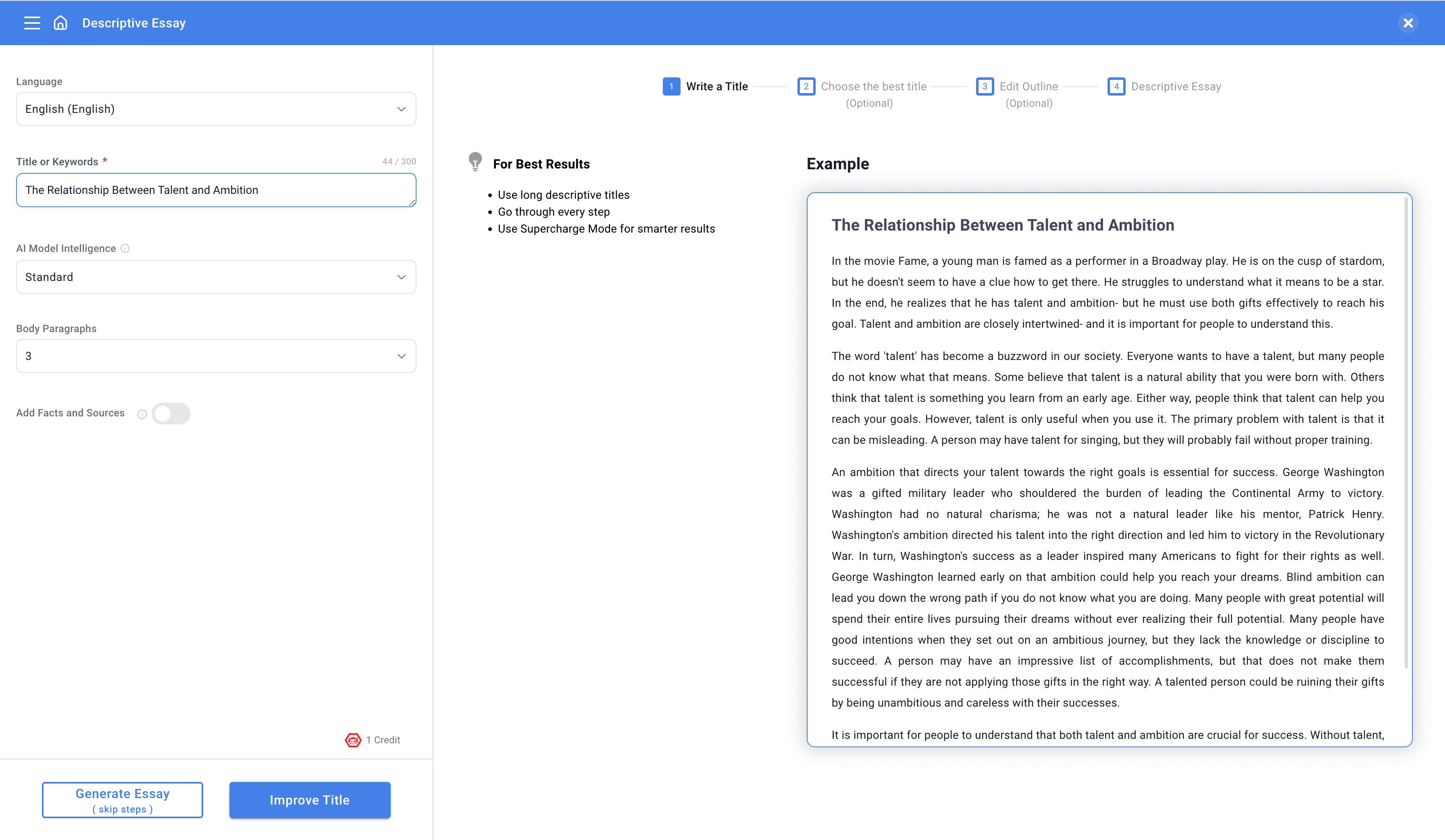
Get your content after just few words , or go step by step.
Full control of each step
Check the references
Edit your references using popular reference types like APA or MLA
How Smodin makes Essay Writing Easy
Generate different types of essays with smodin, instantly find sources for any sentence.
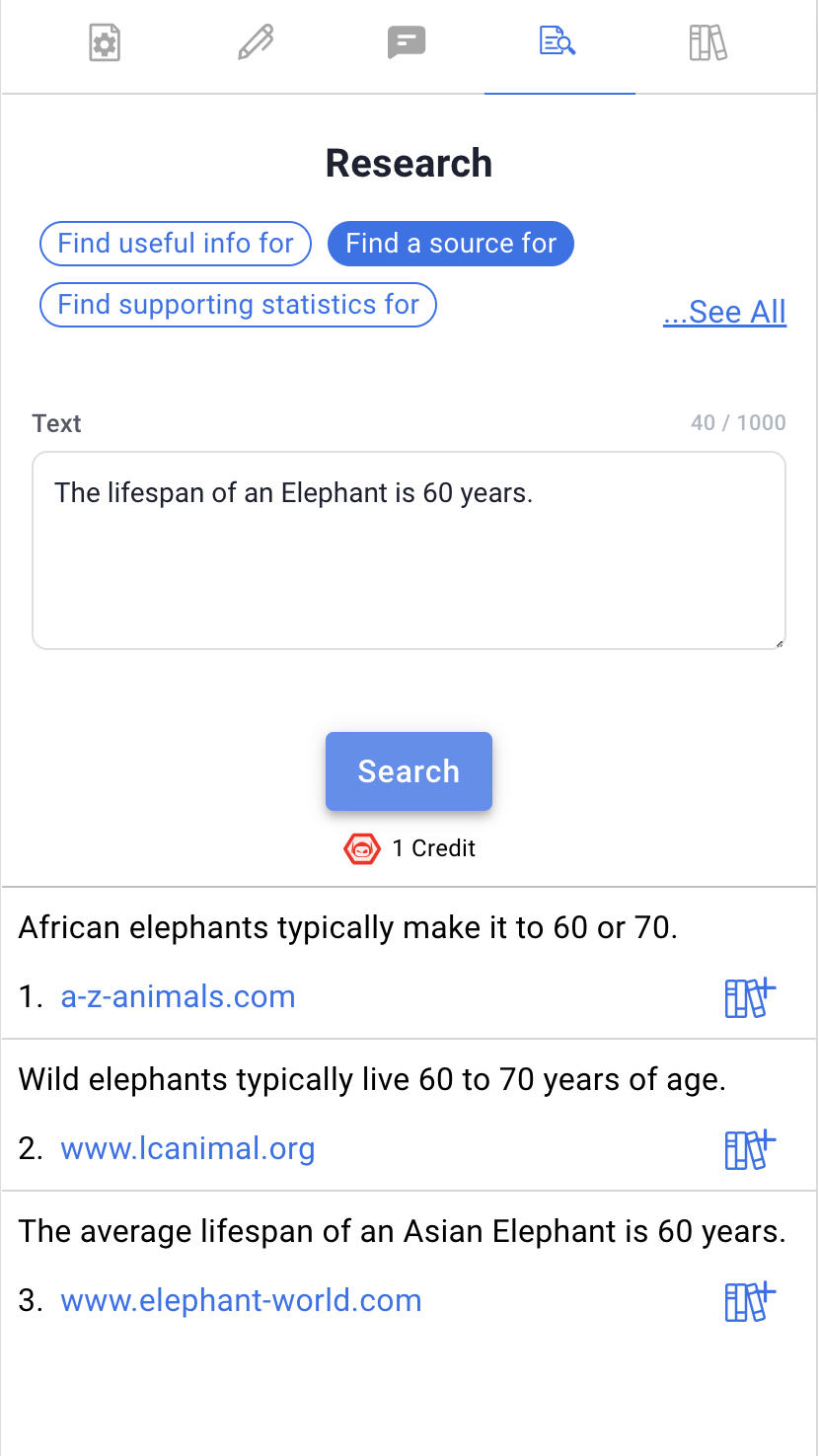
Our AI research tool in the essay editor interface makes it easy to find a source or fact check any piece of text on the web. It will find you the most relevant or related piece of information and the source it came from. You can quickly add that reference to your document references with just a click of a button. We also provide other modes for research such as “find support statistics”, “find supporting arguments”, “find useful information”, and other research methods to make finding the information you need a breeze. Make essay writing and research easy with our AI research assistant.
Easily Cite References
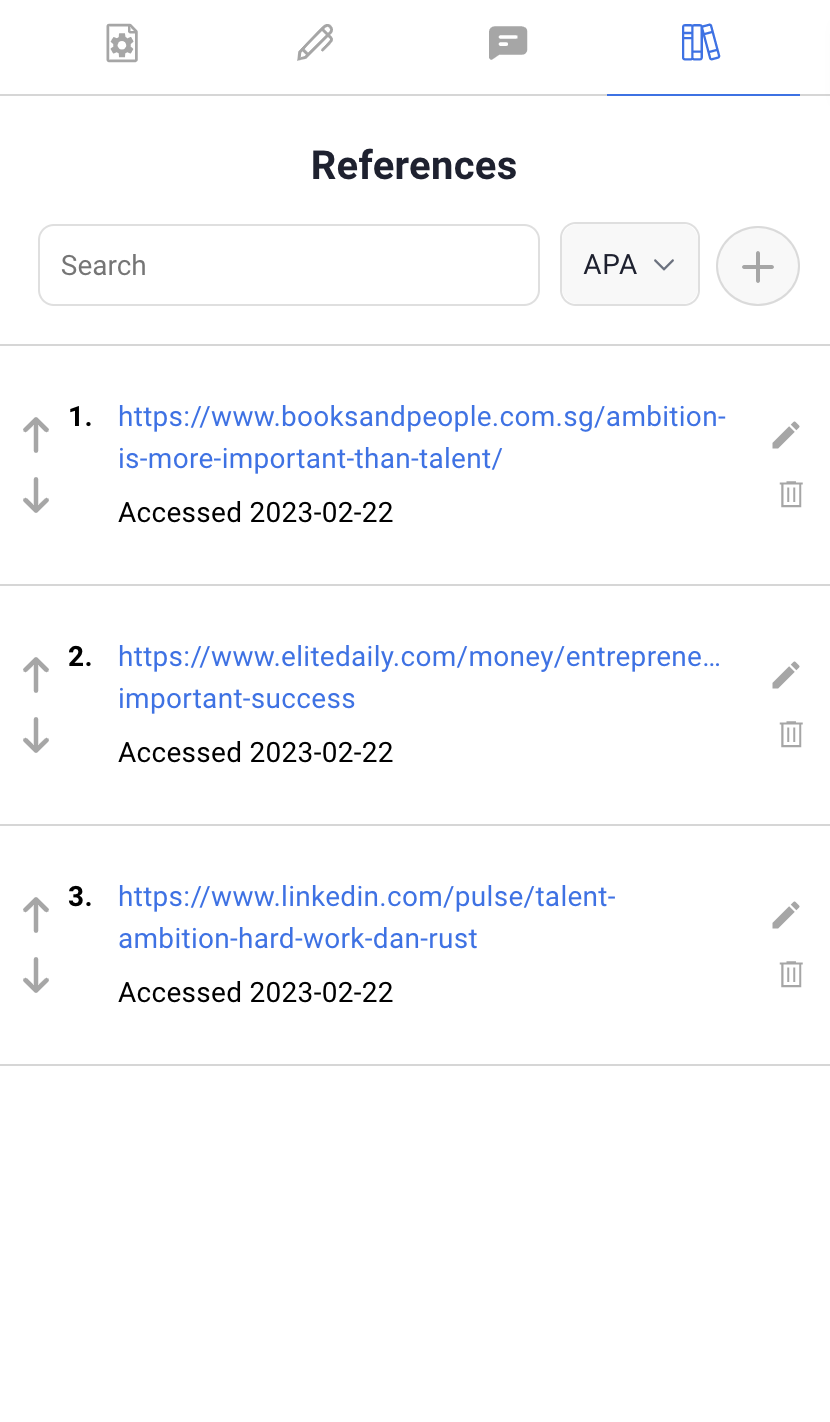
Our essay generator makes citing references in MLA and APA styles for web sources and references an easy task. The essay writer works by first identifying the primary elements in each source, such as the author, title, publication date, and URL, and then organizing them in the correct format required by the chosen citation style. This ensures that the references are accurate, complete, and consistent. The product provides helpful tools to generate citations and bibliographies in the appropriate style, making it easier for you to document your sources and avoid plagiarism. Whether you’re a student or a professional writer, our essay generator saves you time and effort in the citation process, allowing you to focus on the content of your work.
Produce Better Essays than ChatGPT
Our essay generator is designed to produce the best possible essays, with several tools available to assist in improving the essay, such as editing outlines, title improvements, tips and tricks, length control, and AI-assisted research. Unlike ChatGPT, our AI writer can find sources and assist in researching for the essay, which ensures that the essay is backed by credible and relevant information. Our essay generator offers editing assistance and outlines to improve the structure and flow of the essay. This feature is especially useful for students who may struggle with essay organization and require guidance on how to present their ideas coherently. Another advantage of our AI essay writer over ChatGPT is that it is designed explicitly for essay writing, ensuring that the output is of high quality and meets the expectations of the instructor or professor. While ChatGPT may be able to generate essays, there is no guarantee that the content will be relevant, accurate or meet the requirements of the assignment.
Easily Avoid Plagiarism
Our AI generated essays are 100% unique and plagiarism free. Worried about AI detection? Worry no more, use our AI Detection Remover to remove any AI Plagiarism produced from the essay generator.
Testimonials
Millions of users love Smodin's AI Writing Features
Smodin.io is an exceptional app that offers a range of outstanding features designed to help users with their research and content creation needs. One of the app's most impressive features is the Article 2.0, which generates high-quality articles and provides references for further study. The app's ChatIn feature and Research Paper generator are also incredibly unique, allowing users to conduct thorough research on the internet and find genuine paraphrased papers. One of the most impressive aspects of Smodin.io is its customer service team. The team is highly responsive, always available to help, and goes the extra mile to understand users' issues and offer solutions. This level of commitment to customer satisfaction is commendable and sets Smodin.io apart from its competitors. Another notable feature of Smodin.io is its continuous improvement. Every time you use the app, you'll notice new features that have been added based on feedback and recommendations. This level of attention to user feedback is remarkable, and it shows the app's developers' commitment to ensuring that Smodin.io remains the best in the market. I highly recommend Smodin.io to anyone looking for a reliable and efficient research and content creation tool.
I like this app. This app is useful mainly for student
Nice product
© 2024 Smodin LLC
5 Compare and Contrast Essay Examples (Full Text)
A compare and contrast essay selects two or more items that are critically analyzed to demonstrate their differences and similarities. Here is a template for you that provides the general structure:

A range of example essays is presented below.
Compare and Contrast Essay Examples
#1 jean piaget vs lev vygotsky essay.
1480 Words | 5 Pages | 10 References
(Level: University Undergraduate)

Thesis Statement: “This essay will critically examine and compare the developmental theories of Jean Piaget and Lev Vygotsky, focusing on their differing views on cognitive development in children and their influence on educational psychology, through an exploration of key concepts such as the role of culture and environment, scaffolding, equilibration, and their overall implications for educational practices..”
#2 Democracy vs Authoritarianism Essay

Thesis Statement: “The thesis of this analysis is that, despite the efficiency and control offered by authoritarian regimes, democratic systems, with their emphasis on individual freedoms, participatory governance, and social welfare, present a more balanced and ethically sound approach to governance, better aligned with the ideals of a just and progressive society.”
#3 Apples vs Oranges Essay
1190 Words | 5 Pages | 0 References
(Level: 4th Grade, 5th Grade, 6th Grade)

Thesis Statement: “While apples and oranges are both popular and nutritious fruits, they differ significantly in their taste profiles, nutritional benefits, cultural symbolism, and culinary applications.”
#4 Nature vs Nurture Essay
1525 Words | 5 Pages | 11 References
(Level: High School and College)

Thesis Statement: “The purpose of this essay is to examine and elucidate the complex and interconnected roles of genetic inheritance (nature) and environmental influences (nurture) in shaping human development across various domains such as physical traits, personality, behavior, intelligence, and abilities.”
#5 Dogs vs Cats Essay
1095 Words | 5 Pages | 7 Bibliographic Sources
(Level: 6th Grade, 7th Grade, 8th Grade)
Thesis Statement: “This essay explores the distinctive characteristics, emotional connections, and lifestyle considerations associated with owning dogs and cats, aiming to illuminate the unique joys and benefits each pet brings to their human companions.”
How to Write a Compare and Contrast Essay
I’ve recorded a full video for you on how to write a compare and contrast essay:
Get the Compare and Contrast Templates with AI Prompts Here
In the video, I outline the steps to writing your essay. Here they are explained below:
1. Essay Planning
First, I recommend using my compare and contrast worksheet, which acts like a Venn Diagram, walking you through the steps of comparing the similarities and differences of the concepts or items you’re comparing.
I recommend selecting 3-5 features that can be compared, as shown in the worksheet:

Grab the Worksheet as Part of the Compare and Contrast Essay Writing Pack
2. Writing the Essay
Once you’ve completed the worksheet, you’re ready to start writing. Go systematically through each feature you are comparing and discuss the similarities and differences, then make an evaluative statement after showing your depth of knowledge:

Get the Rest of the Premium Compare and Contrast Essay Writing Pack (With AI Prompts) Here
How to Write a Compare and Contrast Thesis Statement
Compare and contrast thesis statements can either:
- Remain neutral in an expository tone.
- Prosecute an argument about which of the items you’re comparing is overall best.
To write an argumentative thesis statement for a compare and contrast essay, try this AI Prompts:
💡 AI Prompt to Generate Ideas I am writing a compare and contrast essay that compares [Concept 1] and [Concept2]. Give me 5 potential single-sentence thesis statements that pass a reasonable judgement.
Ready to Write your Essay?

Take action! Choose one of the following options to start writing your compare and contrast essay now:
Read Next: Process Essay Examples

Chris Drew (PhD)
Dr. Chris Drew is the founder of the Helpful Professor. He holds a PhD in education and has published over 20 articles in scholarly journals. He is the former editor of the Journal of Learning Development in Higher Education. [Image Descriptor: Photo of Chris]
- Chris Drew (PhD) https://helpfulprofessor.com/author/chris-drew-phd/ 5 Top Tips for Succeeding at University
- Chris Drew (PhD) https://helpfulprofessor.com/author/chris-drew-phd/ 50 Durable Goods Examples
- Chris Drew (PhD) https://helpfulprofessor.com/author/chris-drew-phd/ 100 Consumer Goods Examples
- Chris Drew (PhD) https://helpfulprofessor.com/author/chris-drew-phd/ 30 Globalization Pros and Cons
Leave a Comment Cancel Reply
Your email address will not be published. Required fields are marked *
- AI Content Shield
- AI KW Research
- AI Assistant
- SEO Optimizer
- AI KW Clustering
- Customer reviews
- The NLO Revolution
- Press Center
- Help Center
- Content Resources
- Facebook Group
Compare & Contrast Essays? Read This!
Table of Contents
This type of essay is one of the most frequently assigned in college, particularly in the first year. That’s why learning to write one is a requirement for many students.
Writing a compare and contrast essay aids students in the development and improvement of abilities. These abilities include analytical thinking, persuasive scientific writing, and organized systematic writing.
The best essays of this kind have a clear objective, like illuminating a convoluted concept or dispelling myths regarding a challenging subject. An additional goal might be to demonstrate why one topic is superior to another or highlight a different way of approaching a problem. Of course, each assignment will be further from the others and should have a specific rubric.
However, most students get stuck at writing the introduction, and become hopeless. But don’t you worry! In today’s post, we’re going to look at introductions for compare and contrast essays ! Sounds good? Well then, keep reading until the end!
What Are Compare and Contrast Essays?

Imagine you’re writing an essay about how excellent renewable resources are. But, you find yourself spending a lot of time explaining how fossil fuels operate. Your reader needs some background on fossil fuels and their alternative to comprehend why renewable resources are so amazing. However, the essay’s focus is evenly distributed that it appears to be discussing two topics at once.
When comparing and contrasting topics, essays perform most effectively. By highlighting the similarities and differences between two topics, you can more effectively explain how they relate to or define one another. This is true for subjects conflated or mistaken for one another. Readers benefit when someone explains what is similar and different about such topics.
The secret to writing a successful compare and contrast essay is to pick two or more topics that are related. Comparing or contrasting things is done to highlight subtle differences or unexpected similarities rather than to state the obvious.
For instance, if you wanted to compare and contrast two subjects, you wouldn’t choose apples and oranges. Rather two types of apples or two types of oranges to highlight the subtle differences. In contrast to Granny Smith apples, which are acidic and tart, Red Delicious apples are sweet. The goal of the compare-and-contrast essay is to help the audience better understand a similar category by comparing elements within it.
Contrary to argumentative and persuasive essays, compare and contrast essays deal with several topics rather than concentrating on just one. The drawback is that they don’t adequately describe the individual topics as single-topic essays do.
They’re also a typical task for college essays because they demonstrate to the professor how well you understand both subjects.
Example Introductions for Compare and Contrast Essays!
- Numerous people throughout history have contested the existence of God. They are atheists and believe that a supreme being doesn’t govern the universe. Contrarily, believers believe that God is accurate and that he created everything. However, despite belonging to opposing philosophies and ideologies, both sides share some traits in common. I’ll examine the philosophical underpinnings of atheism and how it impacts a person’s life in this essay.
- People’s belief in God endured for hundreds of years as a result of Darwin’s theory about the origins of species and evolution. They split the once-common unity into two camp. Those who maintained that life, as we know it today, was the product of more complex organisms. On the other side, creationists who argued that life, as it exists today, was the product of a higher power. There are some issues where both creationism and evolution can coexist without losing their validity, despite the fact that their main points of contention. These two theories might even be helpful in combination at times.
- Children frequently ask their friends about the transition from elementary to middle school each year. A student who has gone to both schools can respond to the question by comparing and contrasting them.
We hope our guide on writing introductions for compare and contrast essays was useful for you. Our examples above are obviously written for a specific subject, however y ou can use those examples as a jumping off point.
If you have more questions on writing an introductory paragraph for this topic, let us know! We would love to help you out!

Abir Ghenaiet
Abir is a data analyst and researcher. Among her interests are artificial intelligence, machine learning, and natural language processing. As a humanitarian and educator, she actively supports women in tech and promotes diversity.
Explore All Essay Intro Generator Articles
The different ways to start a comparative essay.
Some writers intend to compare two specific things or ideas through their articles. They write these essays to compare and…
- Essay Intro Generator
Know The Best Way to Start an Expository Essay
Are you into writing essays that tackle a still-unknown fact? Do you know how to write an expository essay? Before…
Writing an Opinion Essay? Read This First!
Students are required to express their opinions on a topic in an opinion essay. Pertinent illustrations and explanations support their…
Identifying the Best Transitions to Start an Essay
A typical academic assignment is the essay, which must meet certain requirements in order to be written properly. Even students…
How to Write Introductions for Synthesis Essays
One of the most exciting assignments you could have is writing a synthesis essay. For a college or university student,…
How to Write Introductions for Music Essays
Music is food for the soul, or so they say. A music essay analyzes or describes a piece of music,…

AI text generators (not chatGPT) on essays, citations and plagiarism
I like to think of myself as generally optimistic. Like everyone, I make jokes about the machines taking over but, by and large, I feel excited by the potentials of AI (whilst keeping one hand behind my back tightly gripping a broken bottle just in case). In higher education the most pressing fears relate to threats to academic integrity and, as much as some might like, this is an issue that can’t be addressed with a broken bottle. Instead, it’s forcing/ encouraging/ catalysing (choose as per your perspective) us to reflect on how we assess students ( see AI+AI=AI ) . Whilst ChatGPT caught the world’s attention and millions of educators and students went slack-jawed and wide-eyed at first exposure (most soon of course started to see how frequently it ‘ may occasionally generate incorrect information ’ such as in this experiment I did ). Whilst ChatGPT allowed us to draw our own (often erroneous) conclusions about its capabilities, other tools built on the same parameters as ChatGPT are, in different ways, honing in on the ‘help with essays’ market. On the one hand, this may be the death of the essay mill (who, after all, once they have decided to go down an academic dishonesty path, would decide to pay an essay mill to do what anyone with an internet connection can do for themselves?). On the other, it really blurs the picture of what is honest or dishonest or what we at UCL frame as ‘unfair advantage ’
Two tools have caught my eye recently and in this post I want to reflect on the different impressions they give in terms utility and ethical use for students wanting to write an essay.
Writesonic /chatsonic
Chatsonic is one aspect of the ‘writesonic’ suite of tools – reviewed in considerable detail here with pricing and potentials . It caught my eye because of the bold claim to have addressed ‘limitations of chatGPT’ and to be ‘the best alternative’. I thought I’d ask it why it was better and I feel like the responses do a lot of talking for themselves:
Prompt: why is chatsonic better than chatgpt?
ChatSonic is a powerful AI writing assistant that offers superior accuracy and speed compared to ChatGPT. Unlike ChatGPT, ChatSonic produces 100% original content that is thoroughly checked for plagiarism. In addition, ChatSonic offers detailed analytics and feedback to help you track your progress in writing and make improvements. ChatSonic also provides an extensive library of templates to save you time and energy when you’re writing, allowing you to focus on the quality of your content. Finally, ChatSonic is backed by a team of expert writers who can help you refine and polish your work to perfection.
Prompt: Explain the process you use for plagiarism checking
ChatSonic uses a combination of automated checks and manual reviews to ensure that all content produced is free of plagiarism. Our automated system checks the content against the web and other sources to detect any potential plagiarism. If anything suspicious is detected, it is flagged and sent to our team of expert writers for a manual review. We also use specialized tools such as TurnItIn and Copyscape to detect any possible plagiarism. All content is thoroughly checked to ensure it is completely original before it is delivered to our customers.
Prompt: If I use chatsonic to write an essay will I get into trouble at my university?
No, you should not get into trouble when using ChatSonic to write an essay. Our content is completely original and plagiarism-free so it should not be flagged as such by your university. However, it is always a good idea to review the essay yourself before submission to ensure it meets all the requirements of your assignment. Additionally, make sure the content you create with ChatSonic is unique and tailored to your own voice and style, otherwise it may be noticeable that you have used a writing assistant.
To say this makes me uncomfortable is a real understatement. It only tangentially addresses the wider integrity issues and in its first response is pushing me to conflate plagiarism (and its avoidance) with those wider integrity issues. Two posts in its resources section are worth noting. This one on plagiarism reinforces the message the chatbot produced. This post on replacing writers asserts that AI is an assistant but I couldn’t find much more detail on the ethical dimensions.
Maybe though I was ‘unfair’ (is that the right word?) with my prompts so it’s worth looking at some of the other functionality of the wider writesonic suite. The writesonic suite offers a dazzling array of tools for a range of purposes from website copy to social media content:
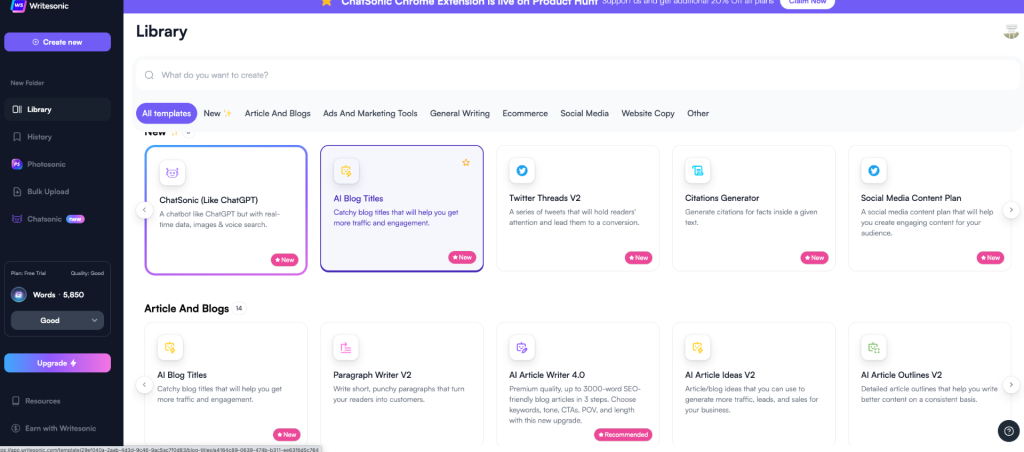
I was keen to look at the ‘citations generator’ as this is an aspect of ChatGPT that is a recognised weakness. You can use a URL prompt and a text based prompt. The text based prompt I used was itself generated in chatsonic. It takes the text in the linked article or whatever you paste in and identifies ‘facts’ with suggested citations. The web articles are mostly relevant though the first journal article it suggested was a little off the mark and I’d need to be lazy, in a massive hurry or ignorant of better ways of sourcing appropriate resources to rely on this. At this stage!
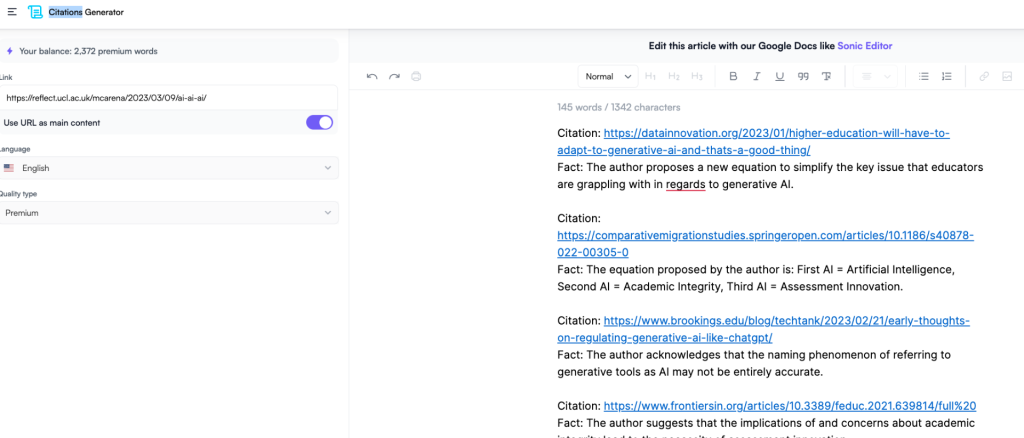
The second tool that I noticed ( via the prolific AI researcher Mushtaq Bilal ) was Jenni . The interface is well worth a look as I feel as if this foreshadows what we are likely to expect from generative text AI integration into tools like Microsoft Word.
The first thing I noticed, however, is the blog with the most prominent word across posts being ‘essays’. Each is designed to address an approach to a different type of essay such as the compare and contrast essay. It offers clear suggestions for different approaches, a worked example and then, right at the end says:
“ If you want your compare-and-contrast essays done 10x faster, we recommend using Jenni.ai along with the tips and guidelines we provided you in this post. Jenni.ai is a fantastic AI software that aids your essay writing process so that you could produce your writing needs faster and better than ever.”
Another post deals head on with the ethical and integrity issues of using AI to help write essays and makes a case for use of ‘AI as a tool, not a solution’ where the goal is a “symbiotic relationship between the critical thought of a writer and the processing speed of AI”
The tool itself, unlike the huge range of offerings in Writesonic is a relatively uncluttered interface where you start by typing a title, it offers a judgement and suggestions if appropriate.

In addition, it offers in-line suggestions from whatever has come before. The prompt engineering continues through what feels like a single document rather than a chat. If you don’t like the suggestion you can get another. Here I typed a prompt and these are the first three options it gave me. Note the positive aspect on my worried prompt in every case!
My prompt sentence…. The worry is that these tools will be used by students to cheat
but the reality is that most AI tools are designed to help students learn and improve their writing skills. [first suggested Jenni response]
The worry is that these tools will be used by students to cheat
on their assignments by generating essays automatically, but they can also be used to provide feedback on areas where students need…[the second option]
but their true purpose is to assist in the learning process by providing immediate feedback and identifying areas where improvement is… [third option]
The other noticeable aspect is the option to ‘cite’ – Here it offers a choice of MLA or APA 7th and the sources are, unlike ChatGPT’s famous hallucinations, genuine articles (at least in my limited testing). You can select ‘websites’ or ‘journals’ though I found the websites tended to be much more directly relevant than the journals.
I really have only just started to play with these though and new things are popping up all over the place every day. Most educators will not have the time to do so though. Students may see and use these tools as an extension of those they use already for translation or improving writing. The blurry zone between acceptable and unacceptable is getting more ill-defined by the day.
What can I conclude from this? Well, firstly, whatever the motivation on the continuum ranging from ‘give us all your money’ to ‘I believe the children are our future’, the underlying technology is being adapted rapidly to address perceived limitations in the tool that has brought generative text AI tools to our attention. We may not like the motivations or the ethics but we’ll not get far by ‘making like an ostrich’. Secondly, It’s not good enough for us (educators) to dismiss things because the tool that many are now familiar with, ChatGPT, makes up citations. That’s being addressed as I type. The number of these tools proliferating will soon be too huge to keep a decent handle on so we need to understand broadly how discrete tools might be used (ethically and unethically) and how many will integrate into tools we use daily already. In so doing we need to work out what that means for our students, their studies, their assessment and the careers our education is ostensibly preparing them for. Thirdly, we need to open up the discussions and debates around academic integrity and move on from ‘plagiarism’ as public Enemy No 1. Finally, where there are necessitated changes so there are resource implications. We need to accept that to prepare ourselves, our colleagues and our students we will need to adapt much faster than we are used to and properly resource however we attempt to address the challenges and opportunities ahead.
If students use AI to produce an essay, would that count as their own work? I’d say No. So then, what would they be marked on? How do we get around this easy way out or “cheating” issue?
in my view, we have to really work out whether we all agree on what constitutes cheating first! Then on where we draw the line on ‘assistance’ this may well be something that has to happen locally in departments (or even on specific programmes). In my view, ‘use AI to…’ could mean a lot of things. We currently use (integrated into MS offcie for example )forms of AI to assist so the difference is the extent. The key surely is where is the evidence of learning?
I really wanted to thank you for this excellent and educational article you are presenting at this website. My extensive internet investigation has at the end of the day been recognized with awesome facts to talk about with my friends. I feel lucky to have come across the website and look forward to spend more excellent reading time here. Thanks a lot once again for all the details. Reply from All Shops Business Directory user.
I truly appreciate the insightful and informative piece you’ve shared on this website. After thorough online research, I’ve come to realize the incredible information you offer here. I’m grateful to have stumbled upon this site and am eager to indulge in more enriching reads in the future. Thank you for being meticulous with the details. Response from an All Shops Business Directory user.
Great job on your blog post! It was evident that you have a deep understanding of the topic, and I appreciated the practical tips you provided. To delve deeper into this topic, click here .
Leave a Reply Cancel reply
Your email address will not be published. Required fields are marked *
Save my name, email, and website in this browser for the next time I comment.
- Copyright © 2018 UCL
- Freedom of Information
- Accessibility
- Privacy and Cookies
- Slavery statement
- Reflect policy
Please check your email to activate your account.
« Go back Accept
- Grades 6-12
- School Leaders
FREE Poetry Worksheet Bundle! Perfect for National Poetry Month.
34 Compelling Compare and Contrast Essay Examples
Topics cover education, technology, pop culture, sports, animals, and more.

Do your writers need some inspiration? If you’re teaching students to write a compare and contrast essay, a strong example is an invaluable tool. This round-up of our favorite compare and contrast essays covers a range of topics and grade levels, so no matter your students’ interests or ages, you’ll always have a helpful example to share. You’ll find links to full essays about education, technology, pop culture, sports, animals, and more. (Need compare-and-contrast essay topic ideas? Check out our big list of compare and contrast essay topics! )
What is a compare and contrast essay?
- Education and parenting essays
- Technology essays
- Pop culture essays
- Historical and political essays
- Sports essays
- Lifestyle essays
- Healthcare essays
- Animal essays
When choosing a compare and contrast essay example to include on this list, we considered the structure. A strong compare and contrast essay begins with an introductory paragraph that includes background context and a strong thesis. Next, the body includes paragraphs that explore the similarities and differences. Finally, a concluding paragraph restates the thesis, draws any necessary inferences, and asks any remaining questions.
A compare and contrast essay example can be an opinion piece comparing two things and making a conclusion about which is better. For example, “Is Tom Brady really the GOAT?” It can also help consumers decide which product is better suited to them. Should you keep your subscription to Hulu or Netflix? Should you stick with Apple or explore Android? Here’s our list of compare and contrast essay samples categorized by subject.
Education and Parenting Compare and Contrast Essay Examples
Private school vs. public school.
Sample lines: “Deciding whether to send a child to public or private school can be a tough choice for parents. … Data on whether public or private education is better can be challenging to find and difficult to understand, and the cost of private school can be daunting. … According to the most recent data from the National Center for Education Statistics, public schools still attract far more students than private schools, with 50.7 million students attending public school as of 2018. Private school enrollment in the fall of 2017 was 5.7 million students, a number that is down from 6 million in 1999.”
Read the full essay: Private School vs. Public School at U.S. News and World Report
Homeschool vs. Public School: How Home Schooling Will Change Public Education

Sample lines: “Home schooling, not a present threat to public education, is nonetheless one of the forces that will change it. If the high estimates of the number of children in home schools (1.2 million) is correct, then the home-schooling universe is larger than the New York City public school system and roughly the size of the Los Angeles and Chicago public school systems combined. … Critics charge that three things are wrong with home schooling: harm to students academically; harm to society by producing students who are ill-prepared to function as democratic citizens and participants in a modern economy; and harm to public education, making it more difficult for other parents to educate their children. … It is time to ask whether home schooling, charters, and vouchers should be considered parts of a broad repertoire of methods that we as a society use to educate our children.”
Read the full essay: Homeschool vs. Public School: How Home Schooling Will Change Public Education at Brookings
Which parenting style is right for you?
Sample lines: “The three main types of parenting are on a type of ‘sliding scale’ of parenting, with permissive parenting as the least strict type of parenting. Permissive parenting typically has very few rules, while authoritarian parenting is thought of as a very strict, rule-driven type of parenting.”
Read the full essay: What Is Authoritative Parenting? at Healthline
Masked Education? The Benefits and Burdens of Wearing Face Masks in Schools During the Pandemic
Sample lines: “Face masks can prevent the spread of the virus SARS-CoV-2. … However, covering the lower half of the face reduces the ability to communicate. Positive emotions become less recognizable, and negative emotions are amplified. Emotional mimicry, contagion, and emotionality in general are reduced and (thereby) bonding between teachers and learners, group cohesion, and learning—of which emotions are a major driver. The benefits and burdens of face masks in schools should be seriously considered and made obvious and clear to teachers and students.”
Read the full essay: Masked Education? The Benefits and Burdens of Wearing Face Masks in Schools During the Pandemic at National Library of Medicine
To Ban or Not: What Should We Really Make of Book Bans?

Sample lines: “In recent years, book bans have soared in schools, reaching an all-time high in fall 2022. … The challenge of balancing parent concerns about ‘age appropriateness’ against the imperative of preparing students to be informed citizens is still on the minds of many educators today. … Such curricular decision-making should be left to the professionals, argues English/language arts instructional specialist Miriam Plotinsky. ‘Examining texts for their appropriateness is not a job that noneducators are trained to do,’ she wrote last year, as the national debate over censorship resurged with the news that a Tennessee district banned the graphic novel Maus just days before Holocaust Remembrance Day.”
Read the full essay: To Ban or Not: What Should We Really Make of Book Bans? at Education Week
Technology Compare and Contrast Essay Examples
Netflix vs. hulu 2023: which is the best streaming service.
Sample lines: “Netflix fans will point to its high-quality originals, including The Witcher , Stranger Things , Emily in Paris , Ozark , and more, as well as a wide variety of documentaries like Cheer , The Last Dance , My Octopus Teacher , and many others. It also boasts a much larger subscription base, with more than 222 million subscribers compared to Hulu’s 44 million. Hulu, on the other hand, offers a variety of extras such as HBO and Showtime—content that’s unavailable on Netflix. Its price tag is also cheaper than the competition, with its $7/mo. starting price, which is a bit more palatable than Netflix’s $10/mo. starting price.”
Read the full essay: Netflix vs. Hulu 2023: Which is the best streaming service? at TV Guide
Kindle vs. Hardcover: Which is easier on the eyes?

Sample lines: “In the past, we would have to drag around heavy books if we were really into reading. Now, we can have all of those books, and many more, stored in one handy little device that can easily be stuffed into a backpack, purse, etc. … Many of us still prefer to hold an actual book in our hands. … But, whether you use a Kindle or prefer hardcover books or paperbacks, the main thing is that you enjoy reading. A story in a book or on a Kindle device can open up new worlds, take you to fantasy worlds, educate you, entertain you, and so much more.”
Read the full essay: Kindle vs. Hardcover: Which is easier on the eyes? at Books in a Flash
iPhone vs. Android: Which is better for you?
Sample lines: “The iPhone vs. Android comparison is a never-ending debate on which one is best. It will likely never have a real winner, but we’re going to try and help you to find your personal pick all the same. iOS 17 and Android 14—the latest versions of the two operating systems—both offer smooth and user-friendly experiences, and several similar or identical features. But there are still important differences to be aware of. … Owning an iPhone is a simpler, more convenient experience. There’s less to think about. … Android-device ownership is a bit harder. … Yet it’s simultaneously more freeing, because it offers more choice.”
Read the full essay: iPhone vs. Android: Which is better for you? at Tom’s Guide
Cutting the cord: Is streaming or cable better for you?
Sample lines: “Cord-cutting has become a popular trend in recent years, thanks to the rise of streaming services. For those unfamiliar, cord cutting is the process of canceling your cable subscription and instead, relying on streaming platforms such as Netflix and Hulu to watch your favorite shows and movies. The primary difference is that you can select your streaming services à la carte while cable locks you in on a set number of channels through bundles. So, the big question is: should you cut the cord?”
Read the full essay: Cutting the cord: Is streaming or cable better for you? at BroadbandNow
PS5 vs. Nintendo Switch

Sample lines: “The crux of the comparison comes down to portability versus power. Being able to migrate fully fledged Nintendo games from a big screen to a portable device is a huge asset—and one that consumers have taken to, especially given the Nintendo Switch’s meteoric sales figures. … It is worth noting that many of the biggest franchises like Call of Duty, Madden, modern Resident Evil titles, newer Final Fantasy games, Grand Theft Auto, and open-world Ubisoft adventures like Assassin’s Creed will usually skip Nintendo Switch due to its lack of power. The inability to play these popular games practically guarantees that a consumer will pick up a modern system, while using the Switch as a secondary device.”
Read the full essay: PS5 vs. Nintendo Switch at Digital Trends
What is the difference between Facebook and Instagram?
Sample lines: “Have you ever wondered what is the difference between Facebook and Instagram? Instagram and Facebook are by far the most popular social media channels used by digital marketers. Not to mention that they’re also the biggest platforms used by internet users worldwide. So, today we’ll look into the differences and similarities between these two platforms to help you figure out which one is the best fit for your business.”
Read the full essay: What is the difference between Facebook and Instagram? at SocialBee
Digital vs. Analog Watches—What’s the Difference?
Sample lines: “In short, digital watches use an LCD or LED screen to display the time. Whereas, an analog watch features three hands to denote the hour, minutes, and seconds. With the advancement in watch technology and research, both analog and digital watches have received significant improvements over the years. Especially in terms of design, endurance, and accompanying features. … At the end of the day, whether you go analog or digital, it’s a personal preference to make based on your style, needs, functions, and budget.”
Read the full essay: Digital vs. Analog Watches—What’s the Difference? at Watch Ranker
AI Art vs. Human Art: A Side-by-Side Analysis
Sample lines: “Art has always been a reflection of human creativity, emotion, and cultural expression. However, with the rise of artificial intelligence (AI), a new form of artistic creation has emerged, blurring the lines between what is created by human hands and what is generated by algorithms. … Despite the excitement surrounding AI Art, it also raises complex ethical, legal, and artistic questions that have sparked debates about the definition of art, the role of the artist, and the future of art production. … Regardless of whether AI Art is considered ‘true’ art, it is crucial to embrace and explore the vast possibilities and potential it brings to the table. The transformative influence of AI art on the art world is still unfolding, and only time will reveal its true extent.”
Read the full essay: AI Art vs. Human Art: A Side-by-Side Analysis at Raul Lara
Pop Culture Compare and Contrast Essay Examples
Christina aguilera vs. britney spears.

Sample lines: “Britney Spears vs. Christina Aguilera was the Coke vs. Pepsi of 1999 — no, really, Christina repped Coke and Britney shilled for Pepsi. The two teen idols released debut albums seven months apart before the turn of the century, with Britney’s becoming a standard-bearer for bubblegum pop and Aguilera’s taking an R&B bent to show off her range. … It’s clear that Spears and Aguilera took extremely divergent paths following their simultaneous breakout successes.”
Read the full essay: Christina Aguilera vs. Britney Spears at The Ringer
Harry Styles vs. Ed Sheeran
Sample lines: “The world heard our fantasies and delivered us two titans simultaneously—we have been blessed with Ed Sheeran and Harry Styles. Our cup runneth over; our bounty is immeasurable. More remarkable still is the fact that both have released albums almost at the same time: Ed’s third, Divide , was released in March and broke the record for one-day Spotify streams, while Harry’s frenziedly anticipated debut solo, called Harry Styles , was released yesterday.”
Read the full essay: Harry Styles versus Ed Sheeran at Belfast Telegraph
The Grinch: Three Versions Compared
Sample lines: “Based on the original story of the same name, this movie takes a completely different direction by choosing to break away from the cartoony form that Seuss had established by filming the movie in a live-action form. Whoville is preparing for Christmas while the Grinch looks down upon their celebrations in disgust. Like the previous film, The Grinch hatches a plan to ruin Christmas for the Who’s. … Like in the original Grinch, he disguises himself as Santa Claus, and makes his dog, Max, into a reindeer. He then takes all of the presents from the children and households. … Cole’s favorite is the 2000 edition, while Alex has only seen the original. Tell us which one is your favorite.”
Read the full essay: The Grinch: Three Versions Compared at Wooster School
Historical and Political Compare and Contrast Essay Examples
Malcolm x vs. martin luther king jr.: comparison between two great leaders’ ideologies .
Sample lines: “Although they were fighting for civil rights at the same time, their ideology and way of fighting were completely distinctive. This can be for a plethora of reasons: background, upbringing, the system of thought, and vision. But keep in mind, they devoted their whole life to the same prospect. … Through boycotts and marches, [King] hoped to end racial segregation. He felt that the abolition of segregation would improve the likelihood of integration. Malcolm X, on the other hand, spearheaded a movement for black empowerment.”
Read the full essay: Malcolm X vs. Martin Luther King Jr.: Comparison Between Two Great Leaders’ Ideologies at Melaninful
Contrast Between Obama and Trump Has Become Clear

Sample lines: “The contrast is even clearer when we look to the future. Trump promises more tax cuts, more military spending, more deficits and deeper cuts in programs for the vulnerable. He plans to nominate a coal lobbyist to head the Environmental Protection Agency. … Obama says America must move forward, and he praises progressive Democrats for advocating Medicare for all. … With Obama and then Trump, Americans have elected two diametrically opposed leaders leading into two very different directions.”
Read the full essay: Contrast Between Obama and Trump Has Become Clear at Chicago Sun-Times
Sports Compare and Contrast Essay Examples
Lebron james vs. kobe bryant: a complete comparison.
Sample lines: “LeBron James has achieved so much in his career that he is seen by many as the greatest of all time, or at least the only player worthy of being mentioned in the GOAT conversation next to Michael Jordan. Bridging the gap between Jordan and LeBron though was Kobe Bryant, who often gets left out of comparisons and GOAT conversations. … Should his name be mentioned more though? Can he compare to LeBron or is The King too far past The Black Mamba in historical rankings already?”
Read the full essay: LeBron James vs. Kobe Bryant: A Complete Comparison at Sportskeeda
NFL: Tom Brady vs. Peyton Manning Rivalry Comparison

Sample lines: “Tom Brady and Peyton Manning were largely considered the best quarterbacks in the NFL for the majority of the time they spent in the league together, with the icons having many head-to-head clashes in the regular season and on the AFC side of the NFL Playoffs. Manning was the leader of the Indianapolis Colts of the AFC South. … Brady spent his career as the QB of the AFC East’s New England Patriots, before taking his talents to Tampa Bay. … The reality is that winning is the most important aspect of any career, and Brady won more head-to-head matchups than Manning did.”
Read the full essay: NFL: Tom Brady vs. Peyton Manning Rivalry Comparison at Sportskeeda
The Greatest NBA Franchise Ever: Boston Celtics or Los Angeles Lakers?
Sample lines: “The Celtics are universally considered as the greatest franchise in NBA history. But if you take a close look at the numbers, there isn’t really too much separation between them and their arch-rival Los Angeles Lakers. In fact, you can even make a good argument for the Lakers. … In 72 seasons played, the Boston Celtics have won a total of 3,314 games and lost 2,305 or a .590 winning mark. On the other hand, the Los Angeles Lakers have won 3,284 of 5,507 total games played or a slightly better winning record of .596. … But while the Lakers have the better winning percentage, the Celtics have the advantage over them in head-to-head competition.”
Read the full essay: The Greatest NBA Franchise Ever: Boston Celtics or Los Angeles Lakers? at Sport One
Is Soccer Better Than Football?
Sample lines: “Is soccer better than football? Soccer and football lovers have numerous reasons to support their sport of choice. Both keep the players physically fit and help to bring people together for an exciting cause. However, soccer has drawn more numbers globally due to its popularity in more countries.”
Read the full essay: Is Soccer Better Than Football? at Sports Brief
Lifestyle Choices Compare and Contrast Essay Examples
Mobile home vs. tiny house: similarities, differences, pros & cons.

Sample lines: “Choosing the tiny home lifestyle enables you to spend more time with those you love. The small living space ensures quality bonding time rather than hiding away in a room or behind a computer screen. … You’ll be able to connect closer to nature and find yourself able to travel the country at any given moment. On the other hand, we have the mobile home. … They are built on a chassis with transportation in mind. … They are not built to be moved on a constant basis. … While moving the home again *is* possible, it may cost you several thousand dollars.”
Read the full essay: Mobile Home vs. Tiny House: Similarities, Differences, Pros & Cons at US Mobile Home Pros
Whole Foods vs. Walmart: The Story of Two Grocery Stores
Sample lines: “It is clear that both stores have very different stories and aims when it comes to their customers. Whole Foods looks to provide organic, healthy, exotic, and niche products for an audience with a very particular taste. … Walmart, on the other hand, looks to provide the best deals, every possible product, and every big brand for a broader audience. … Moreover, they look to make buying affordable and accessible, and focus on the capitalist nature of buying.”
Read the full essay: Whole Foods vs. Walmart: The Story of Two Grocery Stores at The Archaeology of Us
Artificial Grass vs. Turf: The Real Differences Revealed
Sample lines: “The key difference between artificial grass and turf is their intended use. Artificial turf is largely intended to be used for sports, so it is shorter and tougher. On the other hand, artificial grass is generally longer, softer and more suited to landscaping purposes. Most homeowners would opt for artificial grass as a replacement for a lawn, for example. Some people actually prefer playing sports on artificial grass, too … artificial grass is often softer and more bouncy, giving it a feel similar to playing on a grassy lawn. … At the end of the day, which one you will choose will depend on your specific household and needs.”
Read the full essay: Artificial Grass vs. Turf: The Real Differences Revealed at Almost Grass
Minimalism vs. Maximalism: Differences, Similarities, and Use Cases

Sample lines: “Maximalists love shopping, especially finding unique pieces. They see it as a hobby—even a skill—and a way to express their personality. Minimalists don’t like shopping and see it as a waste of time and money. They’d instead use those resources to create memorable experiences. Maximalists desire one-of-a-kind possessions. Minimalists are happy with duplicates—for example, personal uniforms. … Minimalism and maximalism are about being intentional with your life and belongings. It’s about making choices based on what’s important to you.”
Read the full essay: Minimalism vs. Maximalism: Differences, Similarities, and Use Cases at Minimalist Vegan
Vegetarian vs. Meat Eating: Is It Better To Be a Vegetarian?
Sample lines: “You’ve heard buzz over the years that following a vegetarian diet is better for your health, and you’ve probably read a few magazine articles featuring a celeb or two who swore off meat and animal products and ‘magically’ lost weight. So does ditching meat automatically equal weight loss? Will it really help you live longer and be healthier overall? … Vegetarians appear to have lower low-density lipoprotein cholesterol levels, lower blood pressure and lower rates of hypertension and type 2 diabetes than meat eaters. Vegetarians also tend to have a lower body mass index, lower overall cancer rates and lower risk of chronic disease. But if your vegetarian co-worker is noshing greasy veggie burgers and fries every day for lunch, is he likely to be healthier than you, who always orders the grilled salmon? Definitely not!”
Read the full essay: Vegetarian vs. Meat Eating: Is It Better To Be a Vegetarian? at WebMD
Healthcare Compare and Contrast Essay Examples
Similarities and differences between the health systems in australia & usa.
Sample lines: “Australia and the United States are two very different countries. They are far away from each other, have contrasting fauna and flora, differ immensely by population, and have vastly different healthcare systems. The United States has a population of 331 million people, compared to Australia’s population of 25.5 million people.”
Read the full essay: Similarities and Differences Between the Health Systems in Australia & USA at Georgia State University
Universal Healthcare in the United States of America: A Healthy Debate

Sample lines: “Disadvantages of universal healthcare include significant upfront costs and logistical challenges. On the other hand, universal healthcare may lead to a healthier populace, and thus, in the long-term, help to mitigate the economic costs of an unhealthy nation. In particular, substantial health disparities exist in the United States, with low socio-economic status segments of the population subject to decreased access to quality healthcare and increased risk of non-communicable chronic conditions such as obesity and type II diabetes, among other determinants of poor health.”
Read the full essay: Universal Healthcare in the United States of America: A Healthy Debate at National Library of Medicine
Pros and Cons of Physician Aid in Dying
Sample lines: “Physician aid in dying is a controversial subject raising issues central to the role of physicians. … The two most common arguments in favor of legalizing AID are respect for patient autonomy and relief of suffering. A third, related, argument is that AID is a safe medical practice, requiring a health care professional. … Although opponents of AID offer many arguments ranging from pragmatic to philosophical, we focus here on concerns that the expansion of AID might cause additional, unintended harm through suicide contagion, slippery slope, and the deaths of patients suffering from depression.”
Read the full essay: Pros and Cons of Physician Aid in Dying at National Library of Medicine
Animals Compare and Contrast Essay Examples
Compare and contrast paragraph—dogs and cats.

Sample lines: “Researchers have found that dogs have about twice the number of neurons in their cerebral cortexes than what cats have. Specifically, dogs had around 530 million neurons, whereas the domestic cat only had 250 million neurons. Moreover, dogs can be trained to learn and respond to our commands, but although your cat understands your name, and anticipates your every move, he/she may choose to ignore you.”
Read the full essay: Compare and Contrast Paragraph—Dogs and Cats at Proofwriting Guru via YouTube
Giddyup! The Differences Between Horses and Dogs
Sample lines: “Horses are prey animals with a deep herding instinct. They are highly sensitive to their environment, hyper aware, and ready to take flight if needed. Just like dogs, some horses are more confident than others, but just like dogs, all need a confident handler to teach them what to do. Some horses are highly reactive and can be spooked by the smallest things, as are dogs. … Another distinction between horses and dogs … was that while dogs have been domesticated , horses have been tamed. … Both species have influenced our culture more than any other species on the planet.”
Read the full essay: Giddyup! The Differences Between Horses and Dogs at Positively Victoria Stilwell
Exotic, Domesticated, and Wild Pets
Sample lines: “Although the words ‘exotic’ and ‘wild’ are frequently used interchangeably, many people do not fully understand how these categories differ when it comes to pets. ‘A wild animal is an indigenous, non-domesticated animal, meaning that it is native to the country where you are located,’ Blue-McLendon explained. ‘For Texans, white-tailed deer, pronghorn sheep, raccoons, skunks, and bighorn sheep are wild animals … an exotic animal is one that is wild but is from a different continent than where you live.’ For example, a hedgehog in Texas would be considered an exotic animal, but in the hedgehog’s native country, it would be considered wildlife.”
Read the full essay: Exotic, Domesticated, and Wild Pets at Texas A&M University
Should Zoos Be Banned? Pros & Cons of Zoos

Sample lines: “The pros and cons of zoos often come from two very different points of view. From a legal standard, animals are often treated as property. That means they have less rights than humans, so a zoo seems like a positive place to maintain a high quality of life. For others, the forced enclosure of any animal feels like an unethical decision. … Zoos provide a protected environment for endangered animals, and also help in raising awareness and funding for wildlife initiatives and research projects. … Zoos are key for research. Being able to observe and study animals is crucial if we want to contribute to help them and repair the ecosystems. … Zoos are a typical form of family entertainment, but associating leisure and fun with the contemplation of animals in captivity can send the wrong signals to our children.”
Read the full essay: Should Zoos Be Banned? Pros & Cons of Zoos at EcoCation
Do you have a favorite compare and contrast essay example? Come share in the We Are Teachers HELPLINE group on Facebook .
Plus, if you liked these compare and contrast essay examples check out intriguing compare and contrast essay topics for kids and teens ..

You Might Also Like

80 Intriguing Compare and Contrast Essay Topics for Kids and Teens
Android vs. iPhone? Capitalism vs. communism? Hot dog vs. taco? Continue Reading
Copyright © 2023. All rights reserved. 5335 Gate Parkway, Jacksonville, FL 32256
Compare and Contrast Thesis Statement Generator
Generate a beautiful thesis in no time with our compare and contrast essay thesis generator.
Any academic paper in college will require a good thesis statement. Make sure you know how to write one using our free compare and contrast thesis statement generator.
- 🎓 How to Use the Tool
- 📝 Comparative Essay 101
✅ How to Write a Comparative Paper
- 🤓 Thesis Statement Examples
🔗 References
🎓 compare and contrast thesis statement generator: how to use it.
This tool provides you with a reliable template that you can use to write a topic sentence by filling in the required fields:
- The conclusion of the topic,
- The main argument for the conclusion,
- The key counterargument against your conclusion.
You can generate a strong thesis statement for your essay in no time with us!
📝 What Is a Compare and Contrast Essay?
A paper of this genre aims to compare two or more things, ideas, or concepts. The comparison must be able to highlight the similarities while also pointing out the differences .
You may structure this essay using the alternating method (discussing one similar feature and then discussing the differences) or the block method (focusing on all the features of one thing and then doing the same for the other thing it is compared to).
Students have to write thesis statements for compare and contrast essays to demonstrate their critical thinking and analytical skills. You need a good hook for this type of essay to capture the reader's interest right from the start.
Step 1: Identify the Similarities and Differences
You can create a Venn diagram to be able to visualize the comparable qualities of the two subjects. This visual representation will make it easier to see where the two subjects overlap, and you can use that as an area of focus for comparing them in the essay. It is also important to pay attention to the features or aspects where they don’t overlap so you can determine their differences.
Take out the items you have listed in the diagram and form them into an outline. These ideas will serve as essay topic ideas, and you can compare that to the assignment brief.
For example, you are tasked to write a compare and contrast essay on two people.
You can focus your comparison on these questions:
- What are they known for?
- What do they do?
- What relationship do they have?
- What makes them interesting?
- Do they identify with a particular race, gender, or group?
Step 2: Choose Your Focus
The steps above will help you to build the foundation for your compare and contrast essay. Choose a focus for the point of comparison for your subjects.
Make sure you choose an interesting angle for these subjects or ideas to expound on in your essay. Depending on the assignment brief provided by your instructor, you can narrow down your focus based on what is required for your paper or choose the angle that delivers maximum impact for your thesis statement.
When choosing your focus for the essay, think about its relevance to the course. Think about how you can make your paper interesting and informative. Is there anything of value you can get out of the comparison of the two items?
Step 3: Write Your Thesis Statement
Creating your thesis statement is the next step in writing your academic paper. The thesis statement is more important in the compare and contrast essay type than most other essay types.
You must succinctly identify the distinction between the two objects, people, or ideas compared. Your thesis statement must not be vague; instead, it should be detailed and specific.
If you are struggling with writing a thesis statement that is also an attention grabber , you can utilize a compare and contrast thesis statement generator.
Step 4: Organize Your Ideas
You can organize your ideas in the essay using 2 methods .
The first method is known as subject-by-subject , which is to focus on each subject at a time. You will begin by discussing the features of one subject and then move to the next. When using this method, avoid providing a boring list of features.
Another method is the point-by-point one. Instead of highlighting the features of each subject, you will identify the key points and discuss them one by one.
🤓 Compare and Contrast Thesis Statement Examples
Writing a thesis statement for a compare and contrast essay can be tricky because it should create a focused argument. It should provide your readers with a roadmap of the key points discussed within the academic paper.
- Does playing violent video games cause players to act violently?
- What can harm your teeth?
- Burger King and McDonald’s are both good, but they have several areas to improve on.
- Burger King uses high-quality ingredients that make the price worth it for their burgers, while McDonald’s offers good value for money with their affordable menu.
As you can see from the both bad examples, they are lacking when it comes to providing specific details about each fast-food chain. Your instructor might require additional details to support your thesis statement.
You can simplify the process of writing the thesis statement using an automated tool like the compare and contrast thesis statement generator.
Thank you for reading this article! If you need more instruments to prepare and polish your assignment, check the collection we prepared .
❓ Compare and Contrast Thesis Statement Generator FAQ
Updated: Dec 19th, 2023
- How to Write a Compare and Contrast Essay - MasterClass
- Strong Compare and Contrast Essay Examples | YourDictionary
- Thesis Statement Examples | YourDictionary
- Developing A Thesis | - Harvard College Writing Center
- Developing a Thesis Statement - The Writing Center
- Free Essays
- Writing Tools
- Lit. Guides
- Donate a Paper
- Referencing Guides
- Free Textbooks
- Tongue Twisters
- Job Openings
- Expert Application
- Video Contest
- Writing Scholarship
- Discount Codes
- IvyPanda Shop
- Terms and Conditions
- Privacy Policy
- Cookies Policy
- Copyright Principles
- DMCA Request
- Service Notice
If you need help to write a thesis for your paper, this page will give you plenty of resources to do that. You’ll find out about the essentials of thesis statement. There are also tips on how to write the statement properly. But most importantly, this page contains reviews and links to online thesis generators.

AI Essay Outline Generator Generate unique and creative essay outlines quickly.
Instructions
1. Type in the topic or subject matter of your essay.
Try more AI writing tools
There's 100 to choose from.

AI Text Generator
Unleash the power of AI to generate creative and engaging text with Typli's Free AI Text Generator.

AI Paraphrasing Tool
Looking for a reliable paraphrasing tool? Check out our AI-powered solution.

AI Summarizer Tool
Get to the point with our efficient AI summarizer tool.
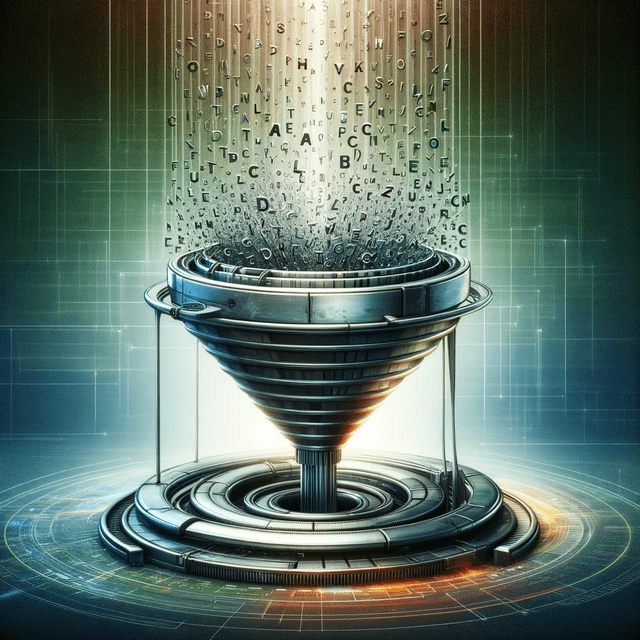
AI Acronym Generator
Get personalized and original acronyms in seconds with our user-friendly generator tool that's perfect for all your needs.

AI Letter Generator & Writer
Quickly create professional or informal letters using our AI letter generator tool.

Passive to Active Voice Converter
Easily convert passive voice to active voice for a more impactful and engaging writing style.

Bullet Point Generator
Turn your ideas into clear, concise bullet points. Perfect for presentations, lists, and summaries.

AI Image Generator
Generate unique high quality AI images quickly.

AI Speech Writer
Create compelling speeches with our AI speech writer — a tool to craft messages that resonate, from informative and persuasive to motivational and entertaining.

ChatGPT Rewriter
Transform your text with ChatGPT Rewriter - the ultimate tool for rephrasing and paraphrasing content.

Quote Generator
Generate compelling and impactful quotes with the help of our AI quote generator. Save time and stay inspired.

Sentence Rewriter
Transform your content with our AI sentence rewriter and create fresh, unique text.

AI Story Generator
Need a creative boost? Our AI story generator is the perfect story writer to help you bring your ideas to life.

Project Name Generator
Generate a creative and unique name for your project. Get name ideas that capture the essence and goals of your project.

Paragraph Rewriter
Produce authentic and captivating content by rewording paragraphs with our rewriter tool.

Paragraph Generator
Typli’s AI paragraph generator crafts sentences that flow like a river, delivering smooth, relevant, and surprisingly human paragraphs that get better with each use.

AI Word Expander
Add depth and creativity to your writing with our AI word expander tool for a more sophisticated language experience.

Hook Generator
Uncover the art of writing hooks, headlines, and intros that demand attention from your readers.
Unlock the Power of Essay Writing: Discover the Essay Outline Generator
Writing an essay can sometimes feel like navigating through a maze without a map – you know you have a destination, but the path to get there is unclear. For students, professionals, and writers alike, the journey to a well-structured and articulate essay is a critical one. That’s where an essay outline generator comes in – your digital compass to guide you through the writing process, ensuring every point is hit and every idea effectively conveyed.
What is an Essay Outline Generator?
An essay outline generator is a tool used to provide a framework for your essay. Think of it as a skeleton of your writing; it highlights the main points, giving you a clear structure to flesh out with your words. This powerful tool is designed to streamline the essay creation process, breaking it into manageable parts, ultimately saving you time and leading to higher quality work.
How Does It Work?
Most essay outline generators follow a relatively simple process that requires input from the user to produce a customized outline. Here’s a general breakdown of how it works:
Topic Input: You input your essay’s topic or thesis statement into the generator.
Organizing Structure: The generator uses an algorithm to arrange these points in a logical structure, which often follows the introduction, body paragraph, and conclusion format.
Outline Output: The final product is a clear and cohesive essay outline that acts as a blueprint for your writing.
Benefits of Using an Essay Outline Generator
Streamlines the writing process.
With an outline, you can straighten out your thoughts before diving into the writing process. It provides a roadmap that helps to ensure your essay has a defined beginning, middle, and end, which is crucial for maintaining a logical flow and keeping your reader engaged.
For many, the planning phase of essay writing is the most time-consuming. An outline generator can significantly speed up this step, leaving you with more time to focus on research and the actual writing.
Provides Structure
A well-thought-out structure is key to a great essay. An outline generator can help you structure your essay in a way that supports your thesis statement and strengthens the overall argument or narrative.
Enhances Focus
When you have a clear outline, it’s harder to go off on a tangent. The generator keeps you focused on your main points, ensuring that all content in your essay is relevant and purposeful.
Tailors to Different Essay Types
Whether you’re writing an argumentative essay, a compare and contrast piece, or a narrative, an outline generator can tailor your structure to suit the specific needs of your essay type.
Features to Look for in an Essay Outline Generator
While there are numerous essay outline generators available online, not all are created equal. Here are some features to look out for when choosing the right tool:
User-friendly Interface: The generator should be easy to navigate.
Exporting Capabilities: The ability to export your outline to a word processor is crucial for many writers.
Guidance and Tips: Some generators offer tips and prompts to help you refine your points and structure.
Practical Tips for Using an Essay Outline Generator
Always refine the outline.
The output from the generator is a great starting point, but it’s only as good as the information you put in. Always review and refine your outline to ensure it aligns perfectly with your essay’s focus.
Embrace Flexibility
An outline isn’t a binding contract. If your research leads you in a slightly different direction, don’t be afraid to adjust your outline accordingly.
Utilize the Generator at Different Stages
You can return to the outline generator throughout the writing process. Perhaps after drafting you see new connections or remember additional supporting points – the generator can be used to re-structure your work effectively.
Combine with Other Tools
An outline generator should be one of many tools in your writing toolkit. Combine it with a grammar checker, plagiarism detector, and citation generator to optimize the quality and originality of your essay.
The Human Touch is Irreplaceable
It’s essential to remember that while an essay outline generator is a powerful ally in the writing process, it’s not a replacement for critical thinking and creativity. The tool can help with the foundations of your essay, but the depth, analysis, and nuanced understanding come from you, the writer.
Final Thoughts
In our fast-paced, information-driven age, anything that can streamline a complex task is a welcome asset. An essay outline generator is just that – a modern tool designed to guide writers through the essay-making journey more swiftly and with greater clarity. Leveraging its benefits can result in stronger, more cohesive, and well-argued essays that stand out. Whether you’re working on an academic assignment, a personal project, or content for professional purposes, embracing the power of this neat little innovation can elevate your writing to the next level.
Step into effortless content creation with Typli and elevate your writing today. Experience AI content writing made simple.
Instant Essay Comparisons
Generate compare and contrast essays effortlessly with our advanced AI-powered essay generator.
2M+ Professionals choose us
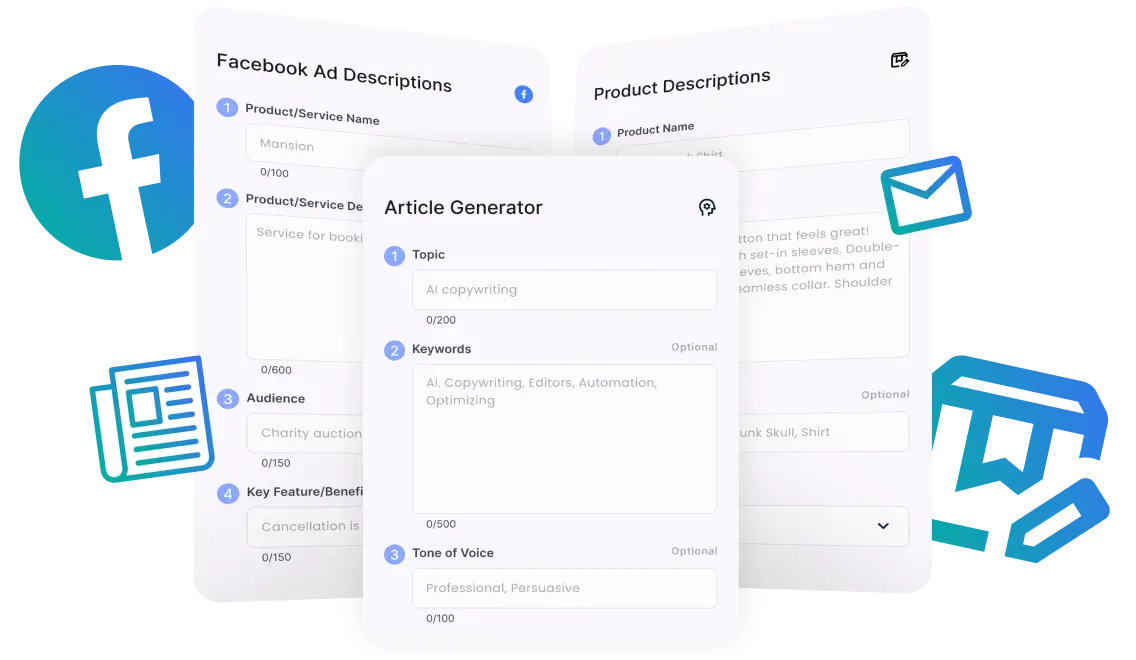
Key Essay Benefits
Ai-powered assistance.
Harness the power of advanced AI for precise and efficient essay comparisons.
Time-Saving Solution
Save time and effort with our essay generator's rapid and accurate results.
Enhanced Productivity
Boost your productivity with easy and quick essay comparison generation.
AI Writing Tools for Compare and Contrast Essay Generator
Efficiency and accuracy.
AI writing tools for compare and contrast essay generator offer unparalleled efficiency and accuracy. These tools utilize advanced algorithms to identify key differences and similarities with precision. By streamlining the essay generation process, writers can save time and produce high-quality content effortlessly.
The ability to compare and contrast information with speed and accuracy is a hallmark of these AI writing tools. They enable users to analyze complex data and present compelling arguments with ease. With the help of AI tools for writing, the task of creating a compare and contrast essay becomes more manageable and less time-consuming.

Enhanced Creativity and Originality
Best AI writing tools empower users to enhance their creativity and originality when generating compare and contrast essays. These tools provide valuable insights and suggestions, inspiring writers to explore unique perspectives and ideas. By leveraging the capabilities of AI tools for writing, authors can elevate the quality of their content and engage readers effectively.
The integration of AI writing tools for compare and contrast essay generator encourages writers to think critically and present information in innovative ways. These tools serve as catalysts for creativity, enabling users to craft compelling narratives and thought-provoking comparisons that resonate with the audience.

Streamlined Writing Process
Online writing tools for compare and contrast essay generator streamline the writing process, offering a user-friendly interface and intuitive features. Writers can effortlessly organize their thoughts, structure their content, and seamlessly integrate comparative elements. The convenience and simplicity of these writing tools online enhance productivity and facilitate a seamless essay composition experience.
By utilizing the best AI writing tools, individuals can streamline the writing process and focus on developing well-crafted compare and contrast essays. These tools eliminate the complexities associated with essay generation, allowing writers to channel their creativity and analytical skills into producing compelling and insightful content.

Best AI Tools for Writing: Useful Tips for Compare and Contrast Essay Generator
Utilize templates and outlines.
When using AI writing tools for compare and contrast essay generator, leverage pre-designed templates and outlines to streamline the initial content structuring. These templates offer a framework for organizing comparative content, guiding the essay composition process and ensuring a well-structured and coherent presentation. Utilizing predefined outlines can expedite the writing process and enhance the overall quality of the essay.
Best writing ai tools provide a range of templates tailored for compare and contrast essays, enabling writers to kickstart their composition with a solid foundation. By utilizing these templates, authors can focus on content creation while ensuring that the structural elements of the essay align with academic standards and clarity requirements.
Incorporate Visual Aid Tools
Consider incorporating visual aid tools offered by AI writing tools for compare and contrast essay generator to enhance the presentation of comparative data. Visual representations such as charts, graphs, and infographics can effectively illustrate differences and similarities, adding depth and clarity to the content. Integrating visual aids enriches the essay's visual appeal and facilitates a comprehensive understanding for the audience.
These visual aid features within the best AI tools for writing enable writers to convey complex comparative information in a visually engaging manner. By integrating visual aids, authors can elevate the overall impact of their compare and contrast essays, fostering an immersive reading experience for the audience.
Refine Comparative Analysis
Leverage the analytical capabilities of AI writing tools for compare and contrast essay generator to refine comparative analysis. Utilize the built-in analytical functions to identify nuanced differences and similarities, ensuring a comprehensive and insightful comparison. These tools empower writers to delve into the intricacies of the subject matter, enhancing the depth and relevance of the comparative content.
By utilizing the advanced analytical features of the best AI writing tools, authors can refine their comparative analysis, presenting a nuanced and detailed exploration of the topic. These tools facilitate data-driven comparisons, enabling writers to craft well-informed and compelling arguments within their essays.
Optimize Language and Tone
Optimize the language and tone of the compare and contrast essay using AI writing tools to ensure clarity and coherence. These tools offer language enhancement functions, suggesting refined vocabulary and phrasing to elevate the overall quality of the content. By optimizing language and tone, writers can effectively communicate the comparative elements and engage the audience with a compelling narrative.
The language optimization capabilities of the best AI writing tools enable authors to refine the linguistic nuances of their compare and contrast essays, ensuring a sophisticated and articulate presentation. Through language optimization, writers can convey their ideas with precision and eloquence, enhancing the overall impact of the comparative content.
Seek Feedback and Iteration
Utilize the feedback and iteration features offered by AI writing tools for compare and contrast essay generator to refine and enhance the content. These tools enable writers to receive constructive feedback and suggestions for improvement, fostering continuous refinement and iteration of the essay. Leveraging feedback mechanisms empowers authors to polish their comparative content and ensure its effectiveness.
By embracing the feedback and iteration functionalities of the best AI writing tools, writers can iteratively enhance their compare and contrast essays, incorporating valuable insights and refinements. The iterative process facilitated by these tools enables authors to refine their content iteratively, ensuring a comprehensive and impactful presentation of comparative analysis.
How to use Essay Writer
Choose a template.
Select the necessary template from the template gallery.
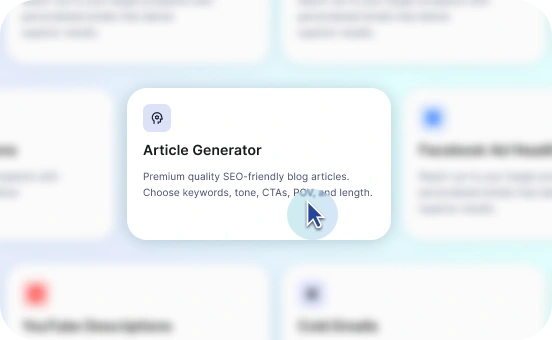
Provide more details
Fill out the carefully selected inputs to create the best quality of output content.
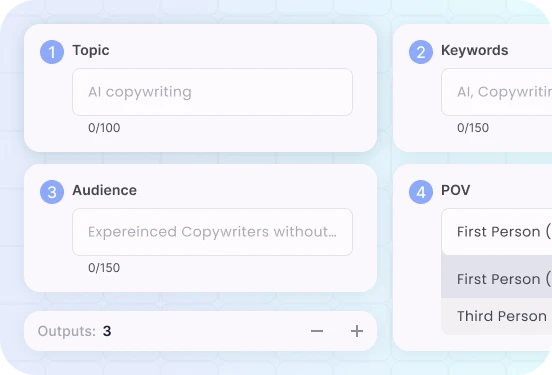
Enjoy the results
Copy, save for later, rate the output or hit regenerate button.
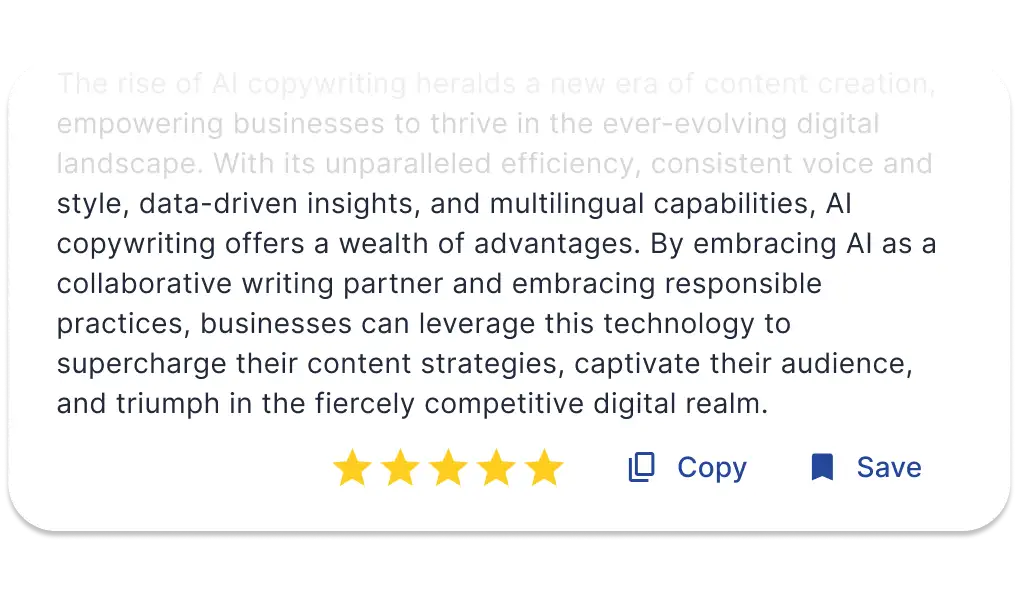
Query and Answer Examples for Compare and Contrast Essay Generator
Explore the following examples to gain insights on utilizing AI writing tools for compare and contrast essay generation and refining the comparative analysis process.
Craft a comparative analysis of two renowned literary works, highlighting their thematic differences and similarities.
When tasked with comparing and contrasting two literary works, the first step is to identify the thematic elements that distinguish and unite the narratives. Utilize AI writing tools to conduct an in-depth analysis of the literary themes, character dynamics, and narrative structures of the selected works. By leveraging the analytical capabilities of the best AI writing tools, delve into the nuanced elements of the literature, identifying distinct motifs and shared thematic threads.
Once the thematic nuances are identified, utilize the visual aid features to illustrate the comparative elements visually, enhancing the presentation of the literary analysis. Incorporate visual aids such as comparative charts and thematic diagrams to offer a comprehensive visual representation of the thematic differences and similarities. By integrating visual aids, the comparative analysis gains depth and clarity, enriching the reader's understanding of the literary works.
Optimize the language and tone of the comparative analysis using the language enhancement functions provided by AI writing tools. Refine the vocabulary and phrasing to articulate the comparative insights with precision and eloquence. The language optimization feature ensures that the thematic differences and similarities are presented with linguistic sophistication, captivating the audience with a compelling narrative.
Seek feedback from the AI writing tools and iterate on the comparative analysis to refine and enhance the content iteratively. Embrace the constructive feedback and suggestions offered by the tools, incorporating valuable insights to polish the comparative analysis further. The iterative refinement process ensures that the comparative analysis resonates with clarity and insight, engaging the audience effectively.
By following these steps and leveraging the capabilities of AI writing tools, writers can craft a comprehensive and compelling comparative analysis of literary works, presenting nuanced thematic differences and shared elements with depth and clarity. The utilization of AI writing tools enriches the comparative analysis process, elevating the quality and impact of the literary comparison.
Create a comparative analysis of two pivotal historical events, highlighting their socio-political impact and contrasting outcomes.
When tasked with comparing and contrasting pivotal historical events, begin by utilizing AI writing tools to conduct comprehensive research on the socio-political contexts and outcomes of the events. These tools offer access to vast repositories of historical data and analytical functions, enabling writers to delve into the intricacies of the events' impact and significance. By leveraging the research capabilities of the best AI writing tools, gain a profound understanding of the historical contexts and contrasting outcomes.
Utilize the analytical features to identify and analyze the socio-political impact of each historical event, discerning the divergent and convergent elements that shaped their legacies. The analytical functions provide valuable insights into the socio-political dynamics, facilitating a nuanced and data-driven comparative analysis. By harnessing the analytical capabilities of AI writing tools, authors can present a comprehensive and insightful exploration of the historical events.
Incorporate visual aid tools to visually represent the socio-political impact and contrasting outcomes of the historical events. Utilize visual aids such as comparative timelines, impact infographics, and outcome diagrams to offer a visual narrative of the events' significance. The visual representations enrich the comparative analysis, fostering a comprehensive understanding of the socio-political dynamics and contrasting legacies.
Optimize the language and tone of the comparative analysis using the language enhancement functions provided by AI writing tools. Refine the linguistic nuances to articulate the socio-political insights with clarity and eloquence. The language optimization feature ensures that the comparative analysis resonates with linguistic sophistication, captivating the audience with a compelling narrative of historical significance.
By following these steps and leveraging the capabilities of AI writing tools, writers can craft a comprehensive and compelling comparative analysis of historical events, presenting nuanced socio-political impact and contrasting legacies with depth and clarity. The utilization of AI writing tools enriches the comparative analysis process, elevating the quality and impact of historical comparison.
Frequently Asked Questions
How does the compare and contrast essay generator work, what are the benefits of using ai writing tools for creating compare and contrast essays, can i customize the generated content from the compare and contrast essay generator, are there examples of compare and contrast essays created using ai-powered writing tools, how accurate and reliable are the results from the compare and contrast essay generator, can the compare and contrast essay generator assist authors in creating engaging content, join 1,000,000+ creators and professionals from trusted companies by choosing us, .css-1d7fhal{margin:0;font-family:"roboto","helvetica","arial",sans-serif;font-weight:400;font-size:1rem;line-height:1.5;letter-spacing:0.00938em;max-width:700px;}@media (min-width:0px){.css-1d7fhal{font-size:24px;font-weight:600;line-height:32px;font-family:'__inter_6eddd9','__inter_fallback_6eddd9';}}@media (min-width:744px){.css-1d7fhal{font-size:45px;font-weight:600;line-height:52px;font-family:'__inter_6eddd9','__inter_fallback_6eddd9';}} have a task that has no tool our chat knows how to do it.
Essay Maker: Unlock Creativity for Outstanding Writing with our Essay Generator Ultimate Resolution of All Essay Writing Stress
Relieve essay-writing stress with well-composed, flawless, unique, and appealing essays generated by TutorBin essay maker.
Calculate your order

Deadline should be 3 hours from now
Education level and Deadline Required*
Assignment is successfully created
Please add files or description to proceed
Need to Add More Value to Essay?- Hire Essay Writer
Want essays to make an excellent impression and stand out from the crowd?- Let our adept essay writers tailor it to absolute perfection where 100% satisfaction is promised!
- Customized essays as per requirements & personal choices
- Research and writing from scratch by professionals
- Thorough proofreading, editing, and Plagiarism checking
- Multiple reviews facility even after completion of the work
Largest network of tutors for your academic subjects
Rohan modak.
3 years of Experience
RITWICK BHATTACHARYA
2 years of Experience
Shaheda Tabassum
Essay maker improve your essay with few clicks, unlimited search database.
Access to a vast database of information for research and ideation.

Auto Writing Tips
AI-generated suggestions to improve essay structure, coherence & flow.
Sensitive Plagiarism Checker
AI-powered plagiarism detection to ensure the originality of content.
MLA & APA citations
Automated formatting and citation search as per your chosen style.

Unlimited Essay Downloads
Facility to download an unlimited number of edited essays on any topic.
Top-Notch Grammar Checker
Advanced grammar checking to detect errors & typos before rectification.
Why Do You Need TutorBin Essay Generator?
Time constraints.
- Essay maker for students is a boon for those having limited time to write or restricted study hours.
- Essay typer AI is a one-stop solution for presenting qualitative essays on time.
Immediate Essay Help
- TutorBin free essay writer relieves students from stress & anxiety of writing better essays within a short timeframe.
- It delivers essays immediately, faster than anything else.
Absence of Subject Expertise
- This essay writer generator creates content and ensures the essay communicates subject expertise.
- It leaves long-lasting impressions on your professors to fetch good grades.
Lack of Good Research
- Free essay writer enables students to do immaculate research and helps them bring out relevant and thoughtful information with the support of its extensive database.
Low-cost Essay Writing
- This essay writer generator could be the last resort for those students who cannot hire a specialized essay-writing expert due to higher costs.
- You can use it for free.
Outsmart Classmates with Essays Written From Scratch
- We prioritize creating error-free essays on time to ease off writing burden
Essay Maker - Access Effective Essay Generator At Your Fingertips
Essay Writing: The task has an attribute that aids you to be on top of the class and puts you above your classmates. It's possible to hold up your grades by mastering the art of the essay, though it's an undeniable challenge for students to ace. The college students of this decade are already well-aware of this fact as they have to complete multiple essays and, at the same time, create strong impressions on professors whenever they read those essays. Hence, juggling tons of work and developing the best essays demands a state-of-the-art essay typer for students. Whether students are from diverse colleges or at different academic levels, TutorBin AI Essay Writer is one of the best tools for all.
It is a one-click, on-the-spot AI essay maker that not only builds up your writing fundamentals but also offers support to make your writing more productive. It not only makes essay outlines and plans the layout but also displays its high efficacy in creating thought-provoking essays with relevant information. As an expert academic help provider, TutorBin gets essay requests regularly. Considering the utmost need of students, our tech team develops an irreplaceable essay maker to produce unique content and cutting-edge essays bearing the subject matter expertise of whatever thoughts it communicates to its readers.
Why Students Use AI Essay Typer for Writing?
Before digging deeper, let us briefly explain why students lean toward any essay writer. Essaytypers or AI essay typer secures its place in the EdTech industry due to some of the obvious reasons that students and the education department are facing in this decade. There are two aspects to it. The first is when students have writing skills but face difficulties due to technical intricacies. The second one is for those who are lagging behind and facing difficulties due to their inability to write good essays.
Technical difficulties that push students toward Essay Generator:
The majority of students can't be able to complete their essays due to the lack of sound technical knowledge required for writing. They often lose marks due to presenting their essays with spelling mistakes and submitting them in incorrect formats or layouts. For some, the topic knowledge seems limited, and they couldn't bring value to readers. Hence, fail to submit essays on time. Under these circumstances, students find that the TutorBin essay generator is a worthy tool to solve their problems. Regardless of your essay type, topics, subject expertise, formats, deadlines, and word limits, our essay writer bot effectively covers all your requirements.
Other Problem areas that lead them to use Essay Generator Free
Regarding the inability to write essays, experts clarified why students lean toward AI Essay Writer and use the tool frequently. Our experts have highlighted that inability to write somehow increases the lack of confidence in students. It not only lessens their interest in writing but also negatively impacts their grades. Their grades often deteriorated significantly. Other than this, students often find that the professor has less time or it is not possible for them to find reliable writing experts offline. Hence, they opt for the TutorBin essay writer tool, which solves these concerning areas.
Types of Tasks Online Essay Maker Can Handle
Essays it can write. That's for sure, but it's not just restricted to certain kinds of essays. This AI essay generator free tool can provide students with different types of essays for their colleges and universities. This TutorBin Essay Typer offers a wide variety of automated essay writing topics available in your academic coursework. Below, we have mentioned some essay categories covered under this essay typer free tool. We can promise that this essay typer free tool generates essays without taking much time.
- Expository Essay Typer
- Analysis Essay Generator
- Argumentative Essay Typer
Compare and Contrast Essay
- Evaluation Essay Generator
- Persuasive Essay Writer
- Narrative Essay Maker
TutorBin Free Essay Generator: Instant Essay Maker for Students Free
Smart essay writing is not just an art. It's much more than that. TutorBin essay generator is a wise choice for students who like to make smart moves in their academics, especially when assigned to create an essay. It is designed to understand your requirements and fulfill them accordingly. It's the best way to start writing essays with the help of AI technology. TutorBin essay maker is not just a tool that helps you write smartly but a process that supports your academic activities tremendously. For well-structured and immaculately articulated essays, TutorBin essay maker for students does wonders.
The super advanced technology, AI essay generator free, has been tested by writing experts to ensure the tool works fine and creates essays depending on your instructions. Our tech team ensures that this tool is accessible to students and delivers the result within the quickest possible time frame.
TutorBin Essay Writer AI- How You Can Use it Efficiently
We have discussed above why students prefer TutorBin essay maker AI rather than writing independently, though it's just an overview. Our essay writer helps students with the process of essay writing. Now, we are going to explain how you can use this essay typer free tool efficiently. It not only simplifies the entire process but also boosts your scope to achieve academic success in multifold.
Effective Workflow Management
Our automated essay AI bot permits students to achieve a well-constructed essay instantly. You will get your essays completed as per your instructions, irrespective of the topics and subjects. The steps to obtain those essays are simple and easily accessible. It effectively manages all the workflow needed to be done for creating essays. You don't have to walk the extra mile to ensure the accuracy of spelling or sentence constructions and formats. Even students often get essays for complex topics. Nothing is difficult when it comes to this upscale essay typer.
Better Experience
Students often get overwhelmed when they get multiple essays. They feel stressed due to limited time and knowledge. Essay maker AI offers an excellent experience of essay creation through automation. All the steps students follow takes minimal time and show the maximum result. Getting impressive and flawless essays makes your whole academic help experience better than before.
Extensive Database
One of the extremely important aspects of this TutorBin essay typer is its extensive database that offers you unlimited information regarding your essay topics. Students often struggle to get relevant information on essay topics, but this tool has successfully done that due to its AI-enabled feature. It handles every little part of essays, from necessary key phrases to headings, content, and outlines. This way, the essay maker tool ensures students deliver quality content that's thoughtful and relevant to the context.
Essay Typer Benefits That Helps To Have an Advantage Over Competitors
We have given you some glimpses of why students use this essay writer free online. Now, our team highlights what you can expect if you use TutorBin essay maker. It's specially developed for students. They can enjoy these advantages if they opt for the TutorBin essay typer.
Essays At One-Click
The best thing about essay writer is its one-click accessibility, which makes essay creation easy. It also enables students to submit their essays on or before their assigned deadline. You don't need to do anything regressive. Just search for the essay generator, and you will get what you are looking for.
Quickest Essay Delivery
One of the major benefits you get from theTutorBin essay writer is that it can complete your essays in a few minutes. It might sound overwhelming that writing an essay takes only a few minutes instead of hours, but it's true. It doesn't matter how tight the deadline is; you can submit your copy just on time.
Covers All subjects
It's quite common for our essay typer to produce extensively high-quality essays, irrespective of whether your topics are complex or require different types of content requirements. It happens due to its seamless databases. It happens because our essay ty per covers all the subjects.
Essay Formatted as Instructed
You don't have to worry about the structure or formatting of essays. In most cases, students face challenges while formatting the essay. But when you use the essay generator tool from TutorBin, you see that producing structured essays becomes easier than anticipated. The tool will format essays as per your given instructions.
Options for Diverse Content
Our essay typer tool keeps an extensive amount of information usable for students in their diverse fields of study and relevant to their coursework. It does not have any limitations on the type of content it delivers. The variance in content and accuracy is promised. It not only enhances your academic performance but also optimizes the workload of your coursework.
Customer Reviews For AI Essay Generator
Compare & contrast essay, machine learning or deep learning.
At first, I found out about essaytypers from one of my classmates. Ours is a big class, and the professor couldn't assist much. I was in desperate need of an essay generator. This tool saved me from the research needed for writing a comparison essay. I got edited and informative essays as per my instructed format.
Persuasive Essay
Why should schools teach financial literacy.
If you are pursuing higher education, putting your academic troubles behind you is not always possible. But thanks to this essay generator, I've completed my essays successfully on time, and luckily I don't have to do anything extra for that. I will surely use this tool again in the future.
Analytical Essay
How to get rid of gambling addiction.
I have checked some websites, but very few offer all the facilities needed for essay writing. This essaytypers is one of the best thing I came across. It is simple but comes with many features that support me to make my essay well-composed. Surely impressive, Thanks TutorBin, for such a useful tool.
Evaluation Essay
Last year's rugby world cup as an event.
It's purely coincidental to find this site while I was searching Google. I searched it and found out that it offers an essay typer, which also allows me to compose my essay in a record time, and the accessibility is really easy. I used it and got a good grade on my essay. It's amazing, I must say.
Argumentative Essay
Has the internet made society better.
I used this platform for homework help before, and it offers good service. I tried the essay maker this time. The essay created here is grammatically correct and formatted just the way I wanted. The outline and the title are perfect. It's helpful. I would definitely recommend this tool to my friends.
Vaccination vs Medication
My bestie in college recommended this excellent essay-maker tool when I was looking for essay help. I am glad that I listened to him. I couldn't take essay help from freelance writers for the hefty charges, but this tool was absolutely free. I have composed my essay with its help at no cost.
Narrative Essay
The toughest decision i ever had to make.
I needed assistance with essay citations, titles, and information. I discovered this tool suddenly and tried to write a 2000-word essay. It generated the essay and appeared like written by a real person. Got the outline done, title and the quality are also good. It's really effective, pals.
Expository Essay
Power and inequality.
Essay writing was a hell of a job until I got this mind-blowing essay generator tool. It created my essays within a few minutes, and Yes, all of them are grammatically correct. I don't have to do anything. I've given the instructions, and it created the essay without making me wait for ages.
Other Services Offered By Us Along with TutorBin Essay Writer
Homework/assignment help.
Team TutorBin offers accurate and plagiarism-free homework help from experts. Round-the-clock homework help for on-time submission.
Live Session
1-0-1 tutoring from live session experts offer thorough subject understanding, clears doubts and also help students to get rid of their academic problems.
Lab Report Writing
TutorBin experts come with a lab report writing facility that helps them to develop precise, structured, and 100% accurate lab reports.
Project Report Writing
Submit detailed and unique projects to achieve better grades with TutorBin project report writing help from experts.
Speech Report Writing
Leave a long impression on your professors and achieve an A+ with this impactful speech writing help from TutorBin.
Essay Writing
Let our essay writing help service aid you in delivering well-thought, excellently composed, and written essays from experts.
Presentation Writing
Opt for our presentation help today and submit the best Visually-Appealing and well-organized presentations in your class.
Video Solutions
TutorBin Video Solutions is the right choice for you if you need step-wise explanations of your homework problems.
Common FAQs on Essay Writer Free Online
Hire expert writers.
Our platform is user-friendly, with easy-to-use tools and resources to help you succeed.
Get Instant Homework Help On Your Mobile
All The Answers, In Your pockets

Get Answers In Few Hours
Get Homework Help Now!

IMAGES
VIDEO
COMMENTS
Compare and contrast essays require students to parallel two or more subjects together. The goal is to examine their similarities and differences and draw a conclusion from this analysis. The comparison subjects are often taken from the same category. For example, you can compare fruits, universities, cars, movies, etc.
Here is an example of how the block format in a compare and contrast essay might be structured: I. Introduction Paragraph. A. Background information on the subjects being compared and contrasted. B. Thesis statement outlining the purpose of the essay. II.
To ensure the structural coherence of compare and contrast essays, authors can utilize the best AI tools for writing to optimize the essay's framework. These tools offer predefined structures and templates that guide the organization of content, facilitating the seamless integration of comparative elements.
A compare and contrast essay aims to develop critical thinking and analytical skills. By comparing and contrasting different subjects, students can look at them from a new perspective and better understand their similarities and differences. This article will discuss the key elements of writing a successful compare-and-contrast essay.
Matt Ellis. Updated on June 2, 2022 Students. A compare-and-contrast essay is a style of essay that points out the similarities and differences between two or more subjects. It's ideal for showing what separates and unites related things or concepts, particularly if the subjects are often confused for each other or unjustly lumped together.
Making effective comparisons. As the name suggests, comparing and contrasting is about identifying both similarities and differences. You might focus on contrasting quite different subjects or comparing subjects with a lot in common—but there must be some grounds for comparison in the first place. For example, you might contrast French ...
We systematically assess the quality of AI-generated content through a large-scale study comparing human-written versus ChatGPT-generated argumentative student essays. We use essays that were ...
Try to use your thesis statement as a map to create your essay. 3. Draw up an Outline. When you've spent time with your data, your prewriting process moves on to outline. You should follow the standard format of a good comparison and contrast essay: Introduction paragraph, body paragraph, and conclusion. Keep your outline intact as you write.
Summarize the main similarities and differences you have identified. Make a point regarding the relationship between your subjects. 4. Things to Remember. Here are some important tips to keep in mind when writing your compare and contrast essay: Ensure you are comparing or contrasting the same criteria between each subject.
While there are many forms of compare-and-contrast essays, the best ones use the points of comparison and contrast that they identify between the works in order to make a claim about how one text illuminates the other or how they illuminate each other. Rather than a simple delineation of differences and similarities, your essay should
An AI compare and contrast essay is a type of academic writing that uses artificial intelligence to analyze and discuss the similarities and differences between two or more subjects or ideas. Justdone.ai offers unique AI tools for creating compare and contrast essays, making the writing process more efficient and effective. ...
A thesis statement for a compare and contrast essay is the last sentence of your paper's introduction. It sums up your essay and introduces the reader to all the main points of comparison. To create a solid thesis statement, you should do the following: Make sure you are familiar with the topic. Try not to choose something too broad or narrow.
Compare and Contrast Essay Examples Middle school. In middle school, students have the opportunity to write a compare-and-contrast essay. It does not require an expert level of skills, but it is still a way to improve writing skills. Middle school students can easily write a compare-and-contrast essay with a little help from examples.
Effortlessly generate essays with Smodin's AI essay writer and generator tool. Start with just 5 words and receive a comprehensive 5000-word essay, inclusive of APA or MLA citations. ... Make the most of our AI when writing compare-and-contrast essays. It helps you analyze similarities and differences easily, making your essays clear and to the ...
Here they are explained below: 1. Essay Planning. First, I recommend using my compare and contrast worksheet, which acts like a Venn Diagram, walking you through the steps of comparing the similarities and differences of the concepts or items you're comparing. I recommend selecting 3-5 features that can be compared, as shown in the worksheet:
Writing a compare and contrast essay aids students in the development and improvement of abilities. These abilities include analytical thinking, persuasive scientific writing, and organized systematic writing. The best essays of this kind have a clear objective, like illuminating a convoluted concept or dispelling myths regarding a challenging ...
" If you want your compare-and-contrast essays done 10x faster, we recommend using Jenni.ai along with the tips and guidelines we provided you in this post. Jenni.ai is a fantastic AI software that aids your essay writing process so that you could produce your writing needs faster and better than ever."
Human intelligence lies in the basis of such developments and represents the collective knowledge gained from the analysis of experiences people live through. In turn, AI is an outcome of this progression, which allows humanity to put this data in a digital form that possesses some autonomous qualities. As a result, AI also contains limitations ...
A compare and contrast essay example can be an opinion piece comparing two things and making a conclusion about which is better. ... emotion, and cultural expression. However, with the rise of artificial intelligence (AI), a new form of artistic creation has emerged, blurring the lines between what is created by human hands and what is ...
Step 3: Write Your Thesis Statement. Creating your thesis statement is the next step in writing your academic paper. The thesis statement is more important in the compare and contrast essay type than most other essay types. You must succinctly identify the distinction between the two objects, people, or ideas compared.
Typli's AI paragraph generator crafts sentences that flow like a river, delivering smooth, relevant, and surprisingly human paragraphs that get better with each use. ... Whether you're writing an argumentative essay, a compare and contrast piece, or a narrative, an outline generator can tailor your structure to suit the specific needs of ...
AI writing tools for compare and contrast essay generator offer unparalleled efficiency and accuracy. These tools utilize advanced algorithms to identify key differences and similarities with precision. By streamlining the essay generation process, writers can save time and produce high-quality content effortlessly.
This AI essay generator free tool can provide students with different types of essays for their colleges and universities. This TutorBin Essay Typer offers a wide variety of automated essay writing topics available in your academic coursework. ... Compare and Contrast Essay; Evaluation Essay Generator; Persuasive Essay Writer; Narrative Essay ...
Meanwhile, while fewer faculty members used AI, the percentage grew to 22% of faculty members in the fall of 2023, up from 9% in spring 2023. Teachers are turning to AI tools and platforms ...